#also I practice with a different pencil and technique to color the eyes and they look cool
Text
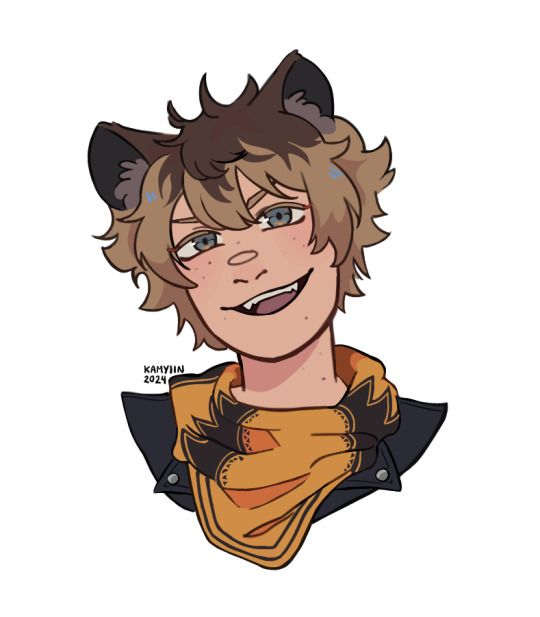
Ruggie is so fun to draw ^^
#twisted wonderland#twst#twst fanart#ruggie bucchi#twst ruggie#my art#dude I love drawing headshots 👌#also I practice with a different pencil and technique to color the eyes and they look cool
82 notes
·
View notes
Text

This is the entry I drew for DeviantArt's "The Holi Mandala Contest". 🏵️✨ I was inspired by the three following things to draw this mandala:
👉My indigenous heritage: My great-great-grandmother, Petrona, was a descendant of indigenous people. She wore her hair in an ankle-length braid and used to tie it over her head to smuggle things across the border, lol. She liked to smoke chala leaf tobacco and her great-grandchildren say she was extremely serious, silent, and that I'm very much like her in appearance. 😊
👉Some of my favorite tarot cards: My paternal grandmother used to read them when I was little and I continue the family tradition since then. 🔮 The cards featured in this mandala are: The World, The Wheel of Fortune, The Sun, The Moon, The Devil, The Magician, The Star, and Death.
👉My meditative practices: I've been meditating for about 20 years and the color palette I picked for this mandala corresponds to the colors of the human Chakra/Energy Centers. 🌈 The Hindu prayer mala beads that appear on it were also inspired by my own set of mala beads, which first belonged to a tibetan monk, and that I was gifted by a kind Tumblr user many years ago. 📿
🧿.🧿.🧿
I've been drawing mandalas since I was a teenager because I've always been fascinated by Hindu culture (the best meditative techniques I've learned come from Hindu and Tibetan cultures) and mandalas are also super relaxing to create and decorate. 🌼
Mandalas are used as a tool for contemplation and meditation, so here's a little explanation of the meaning behind each symbol drawn in the different "gates" (circles/sections) of this one:
🕉️1st Gate (center): The World Card. The Universe. The third eye chakra. The eye that perceives the universe so it can exist. Throat chakra. The power of speech and thought. I think, therefore I am. The chakra at the top of the head. The connection to the whole. The separate individual. Identity. The Self.
🕉️2nd Gate: The Wheel of Fortune Card. Time. Seasons. Inevitable changes. Growth. Movement. The solar system. The Gods of my ancestors. Emotions. Luck. Opposites coexisting as part of a whole.
🕉️3rd Gate: The cards waiting to be turned over. Destiny. The future. What is hidden.
🕉️4th Gate: The flames of Spirit. Creativity. Inspiration. Creation. Destruction. Purification. The sparkle of life.
🕉️5th Gate: My ancestors. The Devil Card. Protection. Strength. Support. Slaves who break their chains and raise their hands from the abyss, setting fire to the darkness. Survival instinct. Determination. The will to carry on.
🕉️6th Gate: The Magician card. The Star card. As above, so below. Manifestation. The morning star appearing in the sky at sunrise and sunset. Liminal spaces. Healing. Miracles. Achieving the impossible. Guides pointing the right way.
🕉️7th Gate: Feathers symbolizing freedom (flying high like a bird) of the mind and spirit (indigo and blue) and feathers symbolizing freedom of the body (red and orange).
🕉️8th Gate: Death Card. Material world/physical plane. Inevitability of change. Transformation. Humanity. The planet earth. Unity. Equality. Connection. We're different, yet we're all the same.
🕉️9th Gate: The laws of nature. Balance. Nothing can exist in the absence of its opposite. Cosmic protection and order. Containment. Harmony between instinct and reason. The Hindu prayer mala beads start the universe in the tassel section and end it when it completes its turn. Ouroboros, the snake that bites its own tail. The cycle of reincarnation. The beyond.
🧿.🧿.🧿
🎨Materials used: Sheet of plain paper, black needlepoint rollerball pen, and "Caran d'Ache" + "Faber-Castell" watercolor coloring pencils.
⏳Drawing & coloring time: 28 hours.
#i sort of forgot to post this here haha#my art#traditional art#no ai used#indigenous art#tarot#tarot cards#mandala#mandala art#meditation#artists on tumblr#support human artists#human artist#visionary art#surreal art#psychedelic art
3 notes
·
View notes
Text
the thing that i dont get about digital art / AI comparisons (saying theyre both "cheating" in the same way, which ive seen a few times from both pro-AI and anti-AI people) is that in AI the only input is like... the text. it doesnt just make things easier or faster, it completely removes your creative control over a piece and automates the entire process. it's like... typing your essay out on google docs (easier and faster than writing by hand, you have access to spell check and dont need to erase or scribble out words you want to remove, formatting is much easier, etc) vs just inputting a prompt into chatGPT. do you understand the comparison im making here? it's literally the exact same concept, except i've never seen someone say that typing your essay on a laptop is cheating because "it's easier which makes you lazy and not a REAL writer, you're the same as the people trying to pass of chatGPT as their own writing".
also, if we're going there... all of the "cheats" you can do with digital art are entirely possible in traditional art (minus stuff like animation which are absolute HELL to do traditionally, especially 3d animation, but that's besides the point). so i don't even get the art-purist "you-can't-call-yourself-a-true-artist" pretentious argument here. YES, traditional art takes longer and costs more to make (you can buy a tablet once for 200 dollars, and connect it to a laptop which most people already have (or just use your phone/tablet which is even cheaper), and then have that be your only expense for YEARS except for replacement pen nibs and cables. meanwhile, sketchbooks are expensive and you need to constantly buy them, colored pencils are expensive if you're serious about it because you need a lot of different colors, paintings are on another level when it comes to materials cost, etc). i genuinely respect traditional artists since that shit is tedious. HOWEVER... saying that digital art is "cheating" kind of reveals to me that you're just unaware of all the potential "cheats" in traditional art. yes, theres some skills you need to learn, like coloring evenly with colored pencils or alcohol markers, or learning brush techniques and blending, color mixing, color matching, taking good photos of your art if you are someone who wants to post on social media, but there are ALSO unique skills you need to learn in digital art, such as managing layer types, learning to disconnect your eyes / hand (if you don't have a screen tablet), optimizing the image for digital viewing, color choosing (WAY HARDER TO DO DIGITALLY THAN TRADITIONALLY). they're equivalent in this way.
however... layering? use a light box and separate your sketch and coloring / lineart layers. undo? use a light box. quickly change colors? plan ahead better. physically paint over part of the piece. want to make multiple colored versions of a piece? cut out a lino block and use different colored ink to make prints. scan the drawing, print out more and color over them. tracing? fucking put the piece of paper over your laptop screen and trace it (we were expected to do this for practice in my high school art classes). mirroring / "flipping the canvas"? hold drawing up to mirror. if youre drawing on paper, hold it up to the sun or use a light box and flip it. symmetry? you can buy tools for this in which you hold a physical mirror up to half of your drawing and trace the reflection. we also used these in art class. you can also use tracing paper for this- it's my preferred method for making symmetrical traditional art, and for redrawing parts of a sketch / full piece that i want to move around or replace. color picking? any method you use digitally you can also use traditionally. the only trouble is IMPLEMENTING said colors in a full piece... but you also have to do that digitally. the biggest hurdle in color picking for traditional art is just... not having the resources to create a certain color easily, but that's a "can't afford a lot of paints / colored pencils / markers" issue, not necessarily a skill issue. even photobashing reference images or rearranging a piece is possible traditionally if you like... cut the sketch out and rearrange it physically before tracing over it, or physically making a reference with the same method. it is not hard and i have done this traditionally before. you can also use tracing paper for this. line stabilization is the only thing i've seen that's actually unique to digital art, but you can mimic this in traditional art by just... weighing down your art tool or having to redo the lineart a few times with the light box method (time consuming, yes, but not necessarily skillful. it just takes longer if you're bad at it, but the SAME results are possible). different layer types? just do the "math" in your head and figure it out. ive literally mimicked multiply layers before without actually using a multiply layer just to see if i COULD, and the results were the same. the only fully 100% true comparison i've seen is that stuff like AI-generated coloring and shading applied to digital art are "cheating" but that's... not digital art at that point... you're just making an argument again AI specifically because they are separate... it's closer to someone recreating an AI image themselves, or editing an AI image to make it look more realistic, which are, again, separate topics. also you can literally shade and fix traditional art with AI too if you take good enough photos of your art so this isn't even really a good argument against digital art specifically, it's an AI issue.
the only argument i see that makes sense is that traditional art, digital art, CGI animation, and AI art are all their own mediums that all require different skill sets (though i'd argue that traditional art and digital art are much more similar to each other in what skills you need than any of them are to AI art, but whatever). which i honestly kind of agree with? or i would is AI art was more ethical and not used in really dumb ways. but i personally think the AI slop is ugly, and my main gripe with it is that people try to "trick" others into believing AI art is real art by refusing to label it, or even labeling it maliciously incorrectly by naming fake artists as a credit for the image. you can't really do this with digital art since it's... pretty obvious when someone is creating something digitally. you know exactly what you're getting.
i think its fine if you want to say that traditional art is better or that you respect it more, because you're allowed your own opinion (even if i think you should at least experience drawing digitally before making a snap judgment). but its not "cheating" and its certainly not comparable to AI
#ai art discourse#<- in case you want to mute. i have this term muted too bc im sick of it LOL#but i had to say something. the arguments are so silly#preaching 2 the choir but whatever#i can draw traditionally AND digitally. i just dont do traditional art rn bc i dont have the money or space#its easier sure but not 'cheating'#i also think the 'its like using chatgpt for a prompt then basing your essay off of it!' argument is dumb.#the equivalent for art is generating an AI image and then redrawing it. again this is something you can do traditionally AND digitally.#not a unique digital art issue!#again its the EXACT same thing as writing your essay in google docs vs physically writing it out with a pencil and paper.#this is a REALLY stupid argument all around
1 note
·
View note
Text
Cute dolphin

#CUTE DOLPHIN PDF#
Some of these adorable dolphin coloring pages would make great decorations to hang up once they are colored in. Place out markers, crayons, or colored pencils and let the kids practice their fine motor skills and different colors on these beautiful creatures while having fun. Some are more intricate designs suitable for older kids and a few are more basic for young kids. What’s Included in Dolphin Coloring PagesĮach dolphin coloring sheet has different dolphin pictures to color on them. Whether you are a Mom, homeschool Mom, teacher, or grandparent, you can print out these cute dolphin coloring sheets on any black and white printer and put them out for kids to color.
#CUTE DOLPHIN PDF#
Ten different dolphin coloring sheets are included in this printable PDF pack (PDF files download button at bottom of the post). Cute Dolphin coloring pages are a fun way for kids of all ages to develop creativity, focus, motor skills and color recognition. In the footage, one dolphin consumed Eight highly deadly yellow-bellied sea snakes ( Hydrophis platurus).Disclosure: This post contains affiliate links from Shareasale, Awin, and . I receive a small commission at no cost to you when you make a purchase using my links (purple text). As an Amazon Associate, I earn from qualifying purchases. Their muscles for sucking add negative pressure that is produced by the increased inner mouth space, according to ScienceAlert.Īlthough dolphins have been observed playing with snakes in the past, including river dolphins messing with a large anaconda, the video provided evidence that dolphins may also consume these reptiles. The dolphins' throat muscles can be seen in the footage springing into action, and their tongues retracted out of the way as they largely swallowed fish into the sides of their open mouths. The footage showed that instead of ramming their prey, the dolphins used suction to gulp down their prey using their powerful throat muscles. The cameras also captured the sound of the animals' racing hearts as they struggled to keep up with the demanding activities. They also used vision and echolocation simultaneously to locate a fish. Read also: US Navy's 'Uncrewed Robotic Minesweeper Ship' Is Now Ready For Deployment Consuming ReptilesĪccording to Ridgway and colleagues, the dolphins appeared to employ both sight and hearing to find prey. More than 200 fish were captured by the dolphins with cameras affixed to them, including bass, croakers, halibut, smelt, and pipefish.īut more interestingly, the dolphins followed their prey's move and used a method previously seen in wild dolphins to swim upside down so their swiveling eyes could see clearly. On contact with fish, buzzing and squealing were almost constant until after the fish was swallowed," the team added. This plushy is made with the highest quality materials, that’s why it will last for a long time. Its soft and pliable quality makes Cute Dolphin Stuffed Animal a favorite for little girls, grown up ladies, and even older people. "On approaching prey, click intervals shorten into a terminal buzz and then a squeal. Cute Dolphin Plush is the perfect gift to give any young woman. NMMF marine mammal veterinarian Sam Ridgway and colleagues said that when the dolphins hunted for food, they clicked continuously at intervals of 20 to 50ms. Their mouths and eyes were seen in startlingly off-angle positions when the recording equipment was positioned on their sides or backs.Īlthough these dolphins are not in the wild, they are regularly given a chance to hunt in the open ocean to supplement their typical frozen fish diet. These recordings have given us fresh perspectives on the hunting techniques and social interactions of these sea mammals. Six bottlenose dolphins (Tursiops truncatus) were equipped with cameras from the US National Marine Mammal Foundation (NMMF), which captured footage and audio over six months.

0 notes
Text
it's just a shadow you're seeing that he's chasing - chapter 11
Warnings: Depression, disordered eating, self harm, suicidal ideation, referenced suicide attempt, meltdown
Summary: Weeks go by and he feels himself deteriorate, feels the thread he’s hanging onto begin to split and fray, and he starts to wonder how this is going to end for him. At what point enough will be enough. or, The one where Spencer goes to the psych ward.
Genre: Angst, hurt/comfort
Word Count: 1.6k
AO3 Link
Chapter 1 - The Enemy Within
Chapter 2 - Errand of Mercy
Chapter 3 - Dagger of the Mind
Chapter 4 - Where No Man Has Gone Before
Chapter 5 - The Galileo Seven
Chapter 6 - This Side of Paradise
Chapter 7 - The Man Trap
Chapter 8 - And the Children Shall Lead
Chapter 9 - Mirror, Mirror
Chapter 10 - A Private Little War
Chapter 11 - Wink of an Eye
Chapter 12 - That Which Survives
Chapter 13 - The Empath
Chapter 14 - Let That Be Your Last Battlefield
Speaking to his mother is like a balm for his soul, and he sleeps without nightmares. In the morning, things look a little bit brighter, a little more hopeful.
Group therapy is centered around coping skills - something Spencer needs desperately - and he finds himself taking copious notes about categories of strategies and techniques for each of them - things like grounding, distraction, humor, self-soothing, behavior modification, seeking support from others… and those are just a few. It’s one of the more practical applications of group, and he’s grateful for it.
Later in the day they have art therapy, which Spencer hasn’t necessarily been dreading, but hasn’t been looking forward to with any particular enthusiasm. He knows he's awkward and uncoordinated and he can't imagine that will serve him well in this endeavor. However, when Molly the Art Therapist arrives, that judgment changes radically.
She has a locked cabinet full of small canvases, different types of paints, brushes of all sizes, magazines and glue and even safety scissors for collages, construction paper, crayons, colored pencils, oil pastels, watercolors, stamps and ink, even origami paper. And she gives them absolutely no guidelines, just free access to all supplies.
Spencer has secretly always wanted to try making art, but never found the time or confidence or justification for procuring the proper supplies. So to have it all laid out in front of him, ready to go, feels like a dream.
He picks out a small canvas and lines up several colors of acrylic paints, squirting a bit of each color onto a plastic palette, and then - to be a little trite about it - paints his emotions.
The sensation of brush against paint against canvas sends tingles down his spine, a stim he is immediately determined to add to his repertoire, and he lets his mind go as he mixes colors and spreads them around, getting lost in brush strokes and even the chemical smell of the paint. He thinks about watching old Bob Ross episodes with his mother, about no mistakes, just happy accidents, and for once he doesn’t hold himself to some impossible standard, just does what feels good.
They’re asked to explain their finished products to the group, and Spencer isn’t really sure what to say, so he just tells the truth.
“The colors make me happy. Purple is my favorite, but I liked blending it with the other colors, too. Mostly, though, I liked the sensation of painting more than the painting itself. I found it to be very centering and soothing. A positive tactile experience, one I hope to recreate in the future.”
A few confused faces stare at him and he tries again.
“Painting feels good,” he shrugs.
He thanks Molly afterward. Here in the hospital, the straightforward psychological techniques and therapies are hardest for him, even though he knows they’re also the most crucial. But it’s the physical ones - the art therapy, the occupational therapy, where he sees immediate results, where he actually feels like he might be getting better, and he’s extremely grateful for that.
During his individual therapy, Carol works on helping him set up a safe space in his mind so they can try EMDR therapy to process some of his trauma. The visualization is difficult for him, but Carol is patient, and Spencer doesn’t give up because he wants this to work. He needs this to work.
In order for that to happen, though, he has to trust Carol fully, and he finds himself spilling the deepest, darkest, most shameful parts of himself to her. He watches carefully to gauge her reaction, but she never flinches. She never accuses him of lying or exaggerating. She never acts like he’s a burden.
It’s a new experience, and one he’s not entirely sure how to process. When he sits motionless staring at the wall for a little bit too long, she asks him about it.
“Don’t you dare tell anyone or I’ll make you regret it,” he whispers, his father’s voice loud in his mind. “Yell all you want, boy, ain’t nobody gonna hear you where you are,” Charles Hankel’s voice butts in. “Something probably triggered it, and instead of dealing with it, he’s acting out.” JJ’s voice cuts like a knife, as though she has a damn clue what she’s talking about. “You deserve this, twerp,” Alexa Lisben sneers, helping to rip his clothes off while everyone watches and laughs. “You’re not my son!” Diana cries, deep in a delusion. “I’m good, I’m fine. Go to him. I’m good, I’m fine.” His own voice, reassuring a traumatized father battling another traumatized father, his knee caught in the crossfire. The memories come hard and fast, and he knows he’s mumbling some of them aloud, is aware that it surely makes no sense to Carol, but she doesn’t seem to mind.
“I’m not weak,” he finally mutters, exhausted. I’m not weak. I’m not weak.”
“No, Spencer,” Carol finally speaks up. “You aren’t weak at all.”
He rests after the session. Before dinner, there’s a yoga class, and he allows himself to stretch out, relax, and let go of the afternoon. He feels connected to his body in a way he never has before. He eats his whole dinner, and he’s showered and ready when visiting hours begin.
---
“Hey, kid,” Rossi says, walking in with a smile and handing Spencer a suspiciously cold cup. “I brought you an affogato,” he says. “Thought you could use a treat.”
“Thanks!” Spencer exclaims, wide-eyed, and while the ice cream is mostly melted into the espresso at this point, it tastes amazing. “Sit down,” he adds, motioning to a chair.
“So, how are you doing?” Rossi asks, and Spencer runs a hand nervously through his hair. It’s not that he doesn’t trust Rossi, it’s just that he’s never been quite so vulnerable around him before, at least when it comes to his personal life.
“I’m okay,” Spencer says after thinking about it for a moment. “Today was better than yesterday.”
“Improvement, then!”
“I guess you could say that.”
“You know we’re all very proud of you for coming here,” Rossi says seriously.
“I would understand you being proud of me if I had taken care of myself before ending up here,” Spencer admits. "I don’t know why everyone is so proud of me for ending up in a mental hospital at all.”
“We’re proud of you for getting help, kiddo,” Rossi says. “Whatever form that might take.”
Spencer nods and sips his drink.
“Carolyn spent time in one of these places,” Rossi says suddenly, and Spencer’s head snaps up.
“She did?”
Rossi nods. “After we lost our son.”
“I didn’t--”
“He only lived a few hours,” Rossi says quietly. “But we loved him already, of course. And Carolyn -- she blamed herself. She needed more help than I could give her, and my first priority was keeping her safe.”
“I’m sorry you both went through that,” Spencer says sincerely.
“I just want you to know that I understand needing some extra help,” Rossi says. “And getting that help is something to be commended, not something to be ashamed of. Spencer, the idea of losing another son…”
It takes Spencer a second to realize what Rossi is saying.
“Stai dicendo che sono tuo figlio?” Spencer whispers.
“First of all, yes,” Rossi says, eyebrows raised. “I am saying you’re my son. Second of all, when the hell did you learn Italian?”
“Oh, it’s just something I picked up when I started working with this weird Italian guy.” Spencer smiles, and Rossi just shakes his head and laughs.
“All right,” Rossi says. “So… best and worst things about being here?”
“Um…” Spencer thinks. “Best: I’ve had some really good conversations with my mother. Worst: I only get good coffee once a day, when you guys bring it to me.”
“Who all have you seen so far?”
“I thought Garcia had a schedule made up.”
“She does. I only looked at which day was mine, though.”
Spencer rolls his eyes. “Hotch, obviously. Penelope. Morgan. Jess and Jack. JJ and Henry.”
“Just Prentiss left, then, huh?”
“Yeah,” Spencer says, looking away. “You think Garcia planned it that way?”
“Depends,” Rossi says. “Are you still mad at her?”
“Mad at her isn’t the right way to put it. I don’t know what I am at her, or if it’s even directed at her at all, whatever it is. It’s complicated. The whole thing is just complicated.”
“They should have told us,” Rossi says.
Spencer hesitates.
“You disagree?”
“Not exactly,” Spencer says. “I just-- I can’t help thinking that if none of it had happened, I wouldn’t have ended up here. And I think this is where I need to be. So…”
Rossi stands up, motioning Spencer to do the same, and gives him a long hug.
“I think this is the most we’ve ever talked,” Rossi admits when they sit back down.
“It’s nice,” Spencer says. “Maybe we should do it more. Maybe I should make a point to, uh, talk to everyone more.”
“I think we’d all like that, kid.”
“I’m sorry if I worried you.”
“All of you worry me. The whole team. It’s part of the job. But you, Spencer… just take care of yourself, okay? You’re more than just a robot or a baby left on the steps of the FBI.”
“A what now?”
“Don’t worry about it.”
“I think visiting hours are over,” Spencer sighs, glancing at the nurse pointing to the clock by the door. “Thank you for coming to see me. And for the dessert.”
“Keep getting better. I’ll see you again real soon. And, kid?”
“Yeah?”
“Don’t be too hard on Prentiss tomorrow, okay?”
“Wouldn’t dream of it.”
#it's just a shadow you're seeing that he's chasing#maya's fics#spencer reid#maya's spencer whump collection#cw depression#cw ed#cw suicidal ideation#cw baby loss
35 notes
·
View notes
Note
7, 20, and 28 for the ask meme!
Thanks!^^
7. A medium of art you don't work in but appreciate
Everything about traditional art (like watercolors, oil, pastel, street art etc. hell even colored pancils) fascinates me as much as it gives me anxiety. I love touching finished canvases, feeling them in my hands, love looking through sketchbook pages, love the smell of paint and markers, love learning about different techniques, love watching others working on their pieces, but I can't do it myself to safe my life (unless it's plain pencil or pens). For some reason my eyes and hands become very sensitive, textures of some materials make me wanna explode and I get overwhelmed real fast, so I can't really enjoy it. That's why I'm sticking to digital art lol
Also, sculputre and 3D modeling are Amazing but I dunno if I'll ever try any of it, cause it looks haaard :p
20. Something everyone else finds hard to draw but you enjoy
Hhhm, I dunno. Maybe, facial expressions? I too can find it not easy to depict a certain microexperession or convey the exact emotion, but when it happens I only get more excited and joyful. I love challenging myself when it comes to drawing difficult expressions - especially if I'm "limited" by the specifics of character design, like the clones, who don't have actual eyebrows and visible pupils (plus they literally have the same face)
28. Any art events you have participated in the past (like zines)
Well, I've participated in Secret Santa events for artist both irl and online, it's super fun and wholesome^^
Oh and I remember back in 2018 there were weekly art challenges in one russian YandereSim fan group. Yeah the game is controversial and problematic af, but the fandom was nice and those weekly events motivated me to practice more :)
I also love Entrapdak Positivity Month, definately going to participate again!
Aaand I was a part of the second Entrapdak Zine this year. Wish I could participate in the other two, but since those were early summer zines and the period from March to July is always the busiest for me it's was nearly impposible. Hopefully there're more fandom events coming soon, I'm very excited and ready to make more art!
2 notes
·
View notes
Text
Youth I

Chapter One - Pilot
Word count: 2k
Series Summary: On a family trip to your dad’s home town of Hawkins, Indiana, you make a series of decisions that result in you ending up in the year 1983 with more questions than there are answers presently available.
Pairing: Steve Harrington x Female Reader ( slow burn )
Chapter Summary: You go through what’s become your new ‘normal’ at Hawkins High School
⟛⟛
Nothing about your current situation was settling right in your stomach. There were no answers as to how you got here, and you didn’t have any questions that could easily be answered. A series of unfortunate events resulted in the attitude you carried. You used to be sweet, all smiles and laughter unless someone did something to make you upset.
What happened to that girl? The girl who grew up never experiencing fear to the point where it worried her parents and made teachers concerned because she’d climb so high on the playground that if you fell, you’d surely break something.
You’d climbed so high on something, and you fell into this situation, and something did break. Your bravery, your fearlessness, nothing physical, but those two things were shattered, and your ego bruised.
Nothing was like what you were used to. To you, everything in this school hallway was dated. The fashion, the haircuts, the textbooks, and the tech.
The stereotypes.
“L/n!”
You shook your head, already knowing whose voice that was. A teenage boy who fit the typical ‘jock’ stereotype that everyone knew. The kid who hated his small town, he got around, played a sport his father probably hated, who would likely never get out of said small town he hated. Yeah, you knew the pattern. Everyone, where you were from, did.
“No.”
You continued on your trek to the locker, but you could hear the slight squeaking of the soles of the older boy’s Nikes on the linoleum floor trying to catch up. Where you were from, people would be staring at this type of occurrence, but because none of the students surrounding you even batted an eye at the basketball player or you for that matter, told you that it wasn’t abnormal for him to be audacious.
“Hey now, I just wanna talk.” He defended, finally catching up to you, walking alongside, but a little bit behind so he didn’t get in anyone’s way.
“Harrington, the last time you wanted to ‘talk’ was when you needed my math homework.” A chuckle escaped you as you said it, finally stopping at your locker.
“In my defense, you don’t look like a sophomore.” He tried, standing next to you as you were spinning the knob in the locker to get it open.
“Whatever, what do you want?”
“Wow, you’re grumpy. Anyways, Tommy H, Carol, and I wanna hang out but my parents don’t leave for another week, and we can’t be at Carol’s place because her mom hates Tommy, and well, you know how Tommy’s dad is.”
You hummed in amusement. “Yeah, he’s a dick, how does that involve me?” You had your binder and pencil case in one arm, staring at him with your hand inside of your locker, holding onto the cup of coffee.
“Can we hang out at your place?”
Rolling your eyes you kneeled down, placing your things down on the ground before standing upright, grabbing the collar of his jacket and pulling it towards your locker, placing it inside before closing the door on it. “Not happening.” You responded, a bright smile on your face as you grabbed your things, taking a step to walk away.
“Y/n! This isn’t funny!”
“I’m gonna correct you on that, it’s not funny to you.” The situation was probably the funniest thing you’d encountered in weeks, and considering your day to day life before used to be full of laughter and playfully teasing, that then went to quiet days spent alone and pondering, this was a nice change.
“Unlock it or I’ll tell Mrs. Jensen!”
Steve’s threat caused you to laugh, holding your things closer so you didn’t drop any of them. “A tattletale? You always did strike me as the type to tease kids in elementary school, but you never did seem like a snitch, you do know the saying right? About snitches?”
“Yeah, from you!” he responded, and although he had a serious face, you knew he was fighting back a smile as well by his voice and how his brows weren’t furrowed in frustration or anger.
“Snitches are bitches, who get stitches and end up in ditches.” it wasn’t intentional for both of you to say it at the same time, but you had, but in two very different tones of voice. Your’s was more ‘matter of fact’ and he was amused.
You stared at him for a second, your smile remaining before you stepped forward, turning the dial of your lock to open it, and once you lifted the lever for the door, Steve got himself out, standing up straight and staring down at you, his hands finding the pockets of his jacket as you closed the locker door again. “That wasn’t fair, you look innocent,” he mumbled to himself.
“I’ll see you later?” Steve asked after a second.
“We have study hall together, so. . . maybe,” you told him, stepping away from the locker and heading down the hallway to your English class.
Bulletin boards on the walls, spaced out between each other, with thumbtacks keeping flyers and announcements up for students to see, lockers for students to keep their things throughout the day. It was all odd.
At your previous schools, lockers weren’t available. That was until your freshman year where you had to pay five dollars a year if you wanted one. And instead of bulletin boards, flyers and announcements would just be taped to the walls, or given during morning announcements, or emailed to students and parents. You were pretty sure your previous high school got rid of lockers in the late ’90s when drugs became prominent in your area and then got rid of bulletin boards when one student sent the other to the hospital with a thumbtack to the wrist, but those types of stories always had a few details in them that never made sense, allowing you to cast doubt on them. But maybe the story had just been told so many times that detail got twisted, the truth of what happened got misconstrued. Like a game of telephone.
Reaching the English classroom, you found your seat, with your anxiousness rising as you sat down, placing your coffee at the upper corner of your small desk, keeping your school supplies close to your chest.
You’d been a happy kid growing up. You didn’t have very many friends, but you had your parents, your little brother, and a condo that you’d been brought home to as a newborn that you knew was a safe place. Unlike the few friends you did have, you never really experienced anxiety or symptoms of depression, but you knew the signs, your closest friend, Mandy, dealt with it, and she confided in you often about how it felt and what it was like, and you often did your own research on it to know what you could to help her.
There were weekends where you spent a good few hours learning different breathing techniques to help her whenever she would have a panic attack, but now that you were dealing with moments where your heart sped up, your hands shook and you felt like something was terribly wrong, it was like all of those hours had been a waste because you couldn’t use them without getting more anxious.
“You okay?”
Looking to your left, you were met with a curious glance from your partner on the English project. Giving an unconvincing nod, you looked down at the top of your desk, eyes tracing over the wood pattern, lines connecting that looked like they shouldn’t, forming shapes and allowing you to distract yourself as Jonathan set his things down as well, taking his seat next to you.
Mrs. Jensen went over the usual, giving instructions for the project that everyone already knew, before leaving everyone to work, with her sitting behind her desk, a book in hand and a container of what you assumed were grapes by the purplish color. Though they could have been large blueberries.
“What’s so important about a quote?” Jonathan mumbled to himself, though it caught your attention from your own worksheet, looking over to him.
“In what context?” you asked, taking a sip from your drink as he began speaking.
“We’re talking about Romeo and Juliet, everyone knows what it’s about, you don’t really need a quote to explain things.”
You nodded when he looked over to you. “A lot of people only really know that it was written by Shakespeare and it’s about two star crossed lovers who kill themselves in the end. Mrs. Jensen probably knew that’s all anyone really remembers, she wants to make sure people know what’s actually happening.
“It’s pretty obvious, ‘Romeo, oh Romeo, wherefore art thou Romeo?’ she’s asking where he is.” He shrugged a bit, placing the book down on the desk, pages open and light reflecting off of the glossy pages.
“No, she’s not,” you told him, getting an odd and questioning look from him. “Well, this was written in the 1500s, English is practically a new language at that point, getting its own footing for once, paintings of historical figures wouldn’t have the English spelling of their names, and English is a language that���s taken a bunch of different parts from other languages, mostly german. If you ever see a period piece that’s set around this period of time, if a child says ‘lady mother’ when they’re addressing their mom, they’re not acknowledging that their mother is a female. They’re acknowledging her title. So her husband is likely a lord of a piece of land, which makes her the lady of that land as well. It was an archaic way of showing respect to their mother by also saying she had a title.”
“How does that relate to the quote?”
“Well, early modern English had many different phrases, and things have changed, we’ve come up with ways to say things that are far more simple. While we think she’s asking where Romeo is, she’s actually asking why he’s Romeo. Why out of all the people she could have fallen for, it had to be him. The enemy. You could use that in the analysis, a bit of how it shows we don’t choose who we love, even if we know we shouldn’t love them.”
Jonathan blinked before looking at his worksheet, picking up his pencil and writing something down, paraphrasing what you had just said and only moments later the bell rang, signaling the end of the class period.
You grabbed your things, leaving as quickly as you could without looking like an idiot, trying to get away from what caused you to be so nervous and make you feel like you could be sick at any moment.
Growing up, you weren’t afraid of many things if any. But maybe you just needed something like this to make you afraid of everything and anything around you. To make you jump at the sound of a drop of water from outside your motel window landing on the metal railing of the stairs and walkway.
But you were terrified, and you wanted to wake up in your own bed, at home, with your dad gently shaking your shoulder to get you up and out of bed. You were terrified you’d never see your parents again, that you’d been too mean to your little brother growing up, and that the last memory he’d have of you was you being mean.
You hadn’t even been afraid to sleep on your own as a kid, and all the things that you weren’t afraid of as a child that you should have been, always seemed to worry your dad. But what would he say and think now? Would he be worried now that you lived in a constant state of fear? Just looking at clothing racks scared you.
Since July you’d been trying to act normal, trying to pretend everything was okay, trying to be your normal self, but your normal self would be odd to everyone else, you knew random things no one else did, you liked things no one even knew about yet, and if you tried to talk about those things, you knew it wouldn’t be a good outcome, not a sour one, but not happy.
⟛⟛
Add yourself to the taglist!
tagging who i know would want to be -
@stonersteve @ilovebucketbarnes
#steve x reader#steve harrington x reader#steve harrington one shot#stranger things x reader#stranger things fanfiction#steve harrington x you
98 notes
·
View notes
Text
Was doodling away today and I thought I'd share a little progress discussion!!!
Ok, so I love me clone bois and I wanted to do a portrait study. First thing's first, If I just draw with no reference my clones don't look very true to cannon.... which is ok, but I really want this one to look like Temuera Morrison. So I pulled up a picture of a rough 3D head-sculpt that I was playing around with in a photo editor:

Now I start laying out the general shape of my head. You'll notice that heads have kind of a rectangular- cylindrical shape. The beginning is very messy, lots of light lines so I can erase later. Also I extend lines way out so I can use the intersections to make the angles on my face.

Going back to look at my reference, I work out all the angles of the face, but I also look for points i can use to measure the size of my face. I'll take my pencil or finger and check the length between the bud of the nose and the chin or the space between the eyes. Compare your measurements.
Notice the forehead and the top of the head are almost 45% of the entire noggin!
See how the tops of the ears line up with the pupils? And the bottom aligns with the mouth?
And how you can connect the center of the eye with the corners of the mouth and the square of his chin?
When I measure one section and compare it to another it makes a huge difference in my perception!!


So now I really get to work fitting in all the various parts of the face. Don't fret too much right now about how perfect anything looks, get them oriented properly first. You'll cry if you spend a ton of time drawing a beautiful mouth and then realize its to far to one side:

I use multiple lines in one area, it also inadvertently gives me the appearance of shadows (in my brain). I might start adding some darker lines if I feel confident about a particular spot. Just keep working your way around the piece and adding lines here, ersing there, tweaking this or that. I jump around a lot so that the drawing is progressing bit by bit as a whole.

My difficulty comes when I get to the right side! I am right handed to my hand wants to move in arcs the right hand accommodates, which means the left sides of my drawings get done first 😅 the right side feels awkward, but I just take it slow and stay patient!! I lay down numerous lines in the same spot until I see shapes that please me. Long strokes, shorter strokes (those guidance lines from the beginning come in real handy here!!!) Once my brain Is happy with everything I go to work with my eraser and get rid of stray lines, smudges, etc and work st the shadowy spots to get the shape right. Often times a swipe with an eraser is as effective as a line with a pencil.

So I'm pretty happy with where I've gotten to!!! I think he looks handsome and stern, and I can see where Morrison's characters inspired me! Total sitting time was probably about 1.5 - 2 hrs. I have to go do chores and things😅, but maybe I can sit and do some ink later!
😨 I'll tell you what... I'm scared of coloring my drawings! I'm not as confident with markers as I am with pencil and ink, and I'm afraid I'll ruin my beautiful picture! But this gives me incentive to practice a lot, and learn new skills like water color painting/ ink wash, and digital coloring!
😁☝ Remember, any skill takes practice! The more you do it, the better you get! Its all about learning how your hands work and developing your own "tool box" of tricks and techniques. Once you find what comes naturally to you, then you can find ways to apply it most effectively! Lastly, don't fuss about mastering everything! I suck at painting and don't have the patience for it. Cannot stand pastels!!! So, I leave that for other folks and stick to my pencils. Also, I am lodged firmly in fantasy art. I can't do ultra-relistic things... and that's ok! I'll just enjoy looking at other people's work!!
Oh, And I had my supervisor handy:

Mam!!! Why has you not drawn me yet???
Lemme know if you enjoyed my lesson!!
#traditional drawing#drawing lessons#pencil on paper#portrait#temuera morrison#clone wars fanart#commander fox#captain rex#commander cody#tips and tricks
48 notes
·
View notes
Photo


“A waltz when she walks in the room,
She pulls back the hair from her face.
She turns to the window to sway in the moonlight...
Even her shadow has grace.
A waltz for the girl out of reach,
She lifts her hands up to the sky.
She moves with the music;
The song is her lover;
The melody's making her cry...
So she dances, in and out of the crowd, like a glance...
This romance is from afar, calling me silently...”
~“So She Dances,” by Josh Groban
x~x~x~x
And to cap off my set of Valentine’s Day posts where I feature my MC’s and someone they care about...last but not least is my HPHL kelpie kid Ru! In the above picture, they’re pictured with Galen Stagg, who belongs to @cursebreakerfarrier, but this picture, this post, and this basic AF pencil test animation are actually about Ru’s relationship with their “keeper” and ttly-not-girlfriend Estrid Soelberg @that-ravenpuff-witch! (I wanted to overlay the two images, but the online sources I tried using to do so weren’t cooperating, so...eh. Here they are separately. XD)
When the kelpie who’d taken on the identity of the Ravenclaw student Rudolph Ollivander first encountered Estrid Soelberg, they did not like her. How could they, when it was because of her that they now wore a silver chain around their neck that she could use like a “leash” and keep them from transforming back into their true form and eating anything or anyone she disapproved of? Naturally Estrid didn’t care for Ru much either -- and really, considering that they nearly ate a first year, that also was pretty understandable. Over time, though, Estrid’s stance softened somewhat, upon realizing that there was an oddly sympathetic side to the carnivorous kelpie.
For one, Ru absolutely loved being at Hogwarts. It wasn’t obvious at first, given how laid-back and aloof they were, but their electric blue eyes were always bright and aware, never missing out on a single detail. Ru would spend hours and hours every day in the Hogwarts library, devouring every book they could. They would explore every corner of the castle grounds and memorize every shred of knowledge that came under their nose. They collected knick knacks and jewelry from Hogsmeade, even going so far as to pierce their ears in their third year, to the horror of all of the adults, both inside and outside of school. And this didn’t even touch on Ru’s great passion for history, magical creatures, Herbology, art, and especially photography. Their still Muggle photographs were always crystal clear and striking, from a view of the Black Lake taken from the Owlery to close-ups on the details of the winged boar statues near the front gates. Ru’s Muggle-style photography came alive in a way that magical photography -- which was still in its infancy and quite low in quality -- couldn’t capture. On the Christmas break of their third year, Ru also discovered and became very enamored with Muggle animation, which made crude drawings come to life -- Estrid, despite her best efforts, couldn’t bite back her laughter upon finding out that Ru had requested the permission of one of the snobbier girls in their year to use her as a model for an animation, only for the finished product to end up being of the girl picking her nose with her pinky finger.
As Estrid got to know Ru better, she decided to try showing them more compassion. For as inhuman as Ru was, and how eccentric, cold, and rude as they could be, their enrollment at Hogwarts truly didn’t seem to be motivated by anything malevolent -- it had truly just been the only way they saw for them to attend this school they’d been watching from afar and longed to see up close. And Estrid treating Ru with more respect and kindness, little by little, wore down Ru’s walls enough that they didn’t dislike her quite so much either. She not only was insightful enough to suss out that they didn’t like eating around other people and showed them the Hogwarts kitchens so that they’d have a place where they could eat in peace, but she didn’t see the need to fill the silence with worthless conversation the way so many of their classmates did. She could sometimes just let a moment be, let the emotions and time just rest for a while. With that, though, Estrid was actually a rather interesting person too, in her own way. She had her fair share of admirers for her appearance (which Ru acknowledged was decent enough, by human sensibilities), but she seemed actively disinterested and uncomfortable about it, instead being the type who was unafraid of being on her own. And yet despite this, Estrid truly wasn’t a loner like Ru was -- she had a gentle hand with creatures of all kinds, an artistic eye, and a soft smile that she rarely showed to much of anyone, but was always sincere. Most striking of all to Ru, though, was the way she moved when she danced. The way her limbs bent and stretched with such grace fascinated Ru. They wished they could slow down time sometimes, just to analyze every tiny little flick of her fingers or flourish of her ankle. Knowing that they couldn’t take enough pictures to capture the grace of her movements, and not yet having a camera that could take moving pictures, Ru settled on trying to animate Estrid. Most of the animations were very crude in the beginning, consisting of nothing but stick figures, but little by little, Ru studied the proportions of the human body (very different than that of a kelpie!) and tried to refine their technique. And before long, all of their animations ended up being modeled on Estrid some way or another -- the vast majority of them being her dancing ballet.
Another person who’d be in the room sometimes when Estrid was dancing was their yearmate Galen Stagg, who often practiced the piano while Estrid was dancing. Ru found the Gryffindor inoffensive for the most part -- like Ru and Estrid, he had a talent for Herbology and Care of Magical Creatures (Ru could sense that Galen in particular had a magical gift for communicating with creatures, even more than Ru themselves did, considering they were actually a kelpie), so sometimes the three of them would end up in the library studying at the same table before a test. Galen was a bit of pansy to Ru’s taste, given his dislike for conflict or confrontation, but he like Estrid was soft-spoken enough that he never gave Ru any real headaches.
One day while Estrid was dancing and Ru sat off on the sidelines (sitting with their legs crumpled up in such a manner that one could wonder if they’d ever learned how to cross their legs properly), Galen took a break from playing to come over and sit down next to the messily-dressed Ravenclaw on the floor. Although he himself really enjoyed drawing too, he’d always felt like Ru tolerated him more than liked him and so had been hesitant to ask Ru if he could see any of their artwork. This day, though, he finally mustered up the courage to ask.
“...May...may I see what you’re working on?”
Ru lowered the page they’d lifted to fine-tune and shot a look out the side of their eye at him.
“...It’s not finished,” they said bluntly.
“That’s all right!” said Galen self-consciously. “That is...I don’t mind, if it’s still sketchy.”
Ru considered him for a moment silently. Just when Galen opened his mouth, ready to say that Ru didn’t have to if they didn’t want to, the kelpie held their sketchbook out in one hand for Galen to take.
With a surprised, but relieved blink, Galen took it and looked at the top page. It was still only a cluster of loosely connected circles and ovals, but Galen could just barely make out what it was.
“It’s Estrid,” he realized, his jade-colored eyes lighting up. “Isn’t it?”
Ru nodded curtly, their gaze drifting off to watch Estrid at the barre.
“That’s just the last frame,” they said in a very low, nonchalant voice.
“Frame?”
“Of animation. Pick up the next eight pages and flip them one by one.”
Galen did so -- and to his delight, he watched as the little cluster of ovals and circles unfolded its arms and spread them in a graceful arc that flourished at the wrists.
“Wow, Ru,” said Galen, impressed, “it looks just like Estrid! I mean, the movement looks just like hers. You really captured the grace of her arms.”
Ru’s electric blue eyes swiveled absently in Galen’s direction, but they didn’t turn around or meet his eyes. Instead their gaze returned to Estrid as they brought up a hand and smoothed some of their long black hair behind their ear.
“...You reckon?” they asked, their quiet voice oddly contemplative.
Galen looked at Ru, surprised. Were they...blushing?
Feeling a wave of compassion for the Ravenclaw all of a sudden, Galen offered them a smile.
“...Yeah. It’s really nice, Ru. I’m sure it’ll be smashing when it’s done.”
Ru’s eyes stayed on Estrid, narrowing slightly.
“The way she moves...” they said lowly, “I’ve never seen anyone else move like that. Even other dancers. It...seems like something that shouldn’t just disappear into the void, when the moment is over...like everything does, sooner or later. I’ve tried to photograph her before, but it doesn’t capture the movement. Even when I take a lot of still pictures one right after another, or when I actively try to get shots that blur, it doesn’t work. And magical photographs...hmph! They’re an absolute joke. They deteriorate so easily, and their quality is atrocious.”
Galen smiled sympathetically. “Well, wizards really have only had them for a short while...I reckon they might need a little time to catch up, right?”
Ru scoffed loudly through their nose and mouth, sounding rather like an offended horse. “It’s pathetic.”
They rested their hands behind them on the floor, leaning back slightly.
“So...the only way I could try to capture the way she moves -- to make it last, past that moment, was to draw it. It’s not exactly easy to get her hands right, though,” they added sourly under their breath.
“Hands are every artist’s Achilles’s heel, I think,” said Galen with a quiet laugh.
His green eyes softened. “...You really care about Estrid a lot, don’t you?”
Ru’s face flushed a bit more darkly as they whirled on him with a glare.
“Don’t read too much into it, Stagg. I find her movements interesting. That’s all.”
Despite Ru’s denials, however, Galen thought to himself that Estrid was pretty lucky, to have someone in her life who’d put in so much effort to try to memorialize her in a lasting way. He wondered if Ru even realized just how sweet and selfless of an instinct that really was.
#hphl#hogwarts legacy#my art#my writing#ru ollivander#estrid soelberg#galen stagg#other people's mcs#I hope galen's written all right honey!#I couldn't find any writing samples for him so I kind of just used the characterization you put down for him as a kick-off point#of course galen is dressed like a proper student while ru is a friggin' mess#you might spot their silver 'bridle' chain around their neck under their collar#and yeah ru doesn't know how tf to sit properly with two legs even after all these years#this kid SLOUCHES CONSTANTLY#drawing their hair was fun though#I'd actually used some choreography done for the dance of the sugarplum fairy while doing that pencil test#it's basic as all get out but hey whatcha gonna do#it admittedly is still good practice for this one project I REALLY want to do for my blog's first anniversary coming up next month...#I love ru and their tsundereness regarding their feelings for estrid so much okay X3
20 notes
·
View notes
Note
Hey I'm Fred's fourth daddy anon! I sent that to you, and what felt like five minutes later you came in with that gorgeous sketch. Do you have any art tips or videos that have taught you cause I've been stuck draw trying to draw anything not resembling a lump for two years. Also yeah it was whirlwind episode, f*ck Rose, and Fred should have turned that loon in.
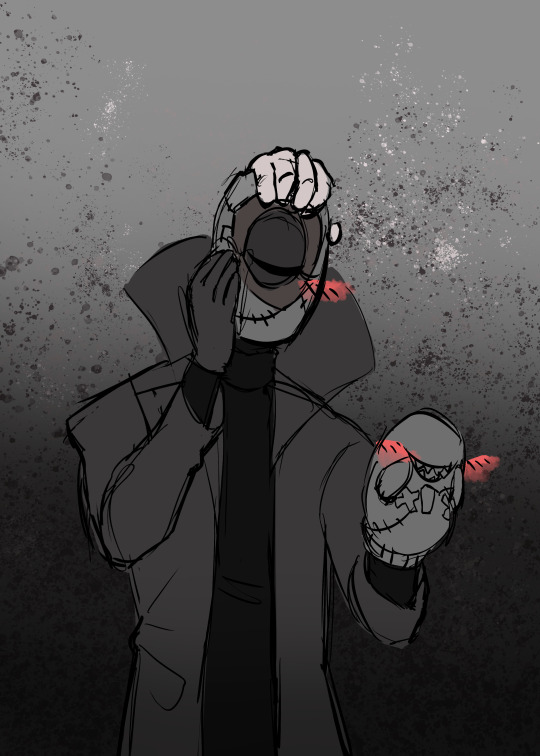
Hey FD Anon, thanks so much! I don’t draw a lot of “horror” art so I’m really happy with it’s progress so far!
While I do agree with you that Rose is The Worst, I think she added in an interesting dynamic and I’d be happy if she became a recurring character in the Scooby mythos at large. As for Fred not turning his dad in... I agree, but I also understand why he didn’t.
The episode went out of it’s way to show off how frightening and weird he is but Fred made it very clear that when he wasn’t wearing the mask he was a good parent, and that all of his crimes were shown as nonviolent. He didn’t seem to steal anything (unless I missed that line?) he just liked messing with people by confusing them.
As for art tips, I... honestly never expected anybody to ask for advice from me? That’s super flattering wow.
Okay, so I’m still pretty much a novice, but lemme give you some of my best tips and tricks:
1) Notice how my last sketch had a grey background? This wasn’t just for that sketch, this is how I use ALL of my digital canvases. I do this because the grey causes less strain to my eyes, and allows me to work longer and more easily. Being so close to a screen, especially a blue or white one, can make it harder to work for long periods of time.


2) If you want to do digital art, you need to learn “traditional art” (pencil and paper) first. It makes transitioning to digital more easy and it’s pretty much what any art teacher would recommend, for good reason.
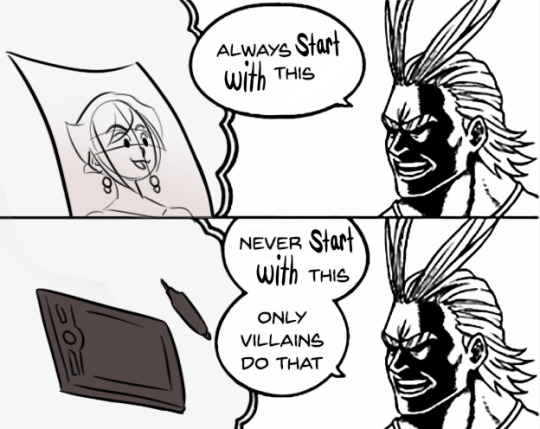
3) Using one method of art not only limits you, but stops you from learning other techniques which can be incorporated into what you typically prefer. Not only that, but you can also discover a medium you really love that you never would have thought of before!

4) Whenever you get the chance, work in black and white or monochrome. This is a great way to help yourself learn about values and intensity, and just looks cool in general.

5) Piggybacking on that last point, if you’re ever worried about your shading, values, etc becoming muddled either A] take a picture and use a filter to make it black and white, or B] create another, pure white layer on top of the others and change it from “Normal” to “Hue”. Doing this can really help change your approach to coloring (black and white effect may be different for every art program).
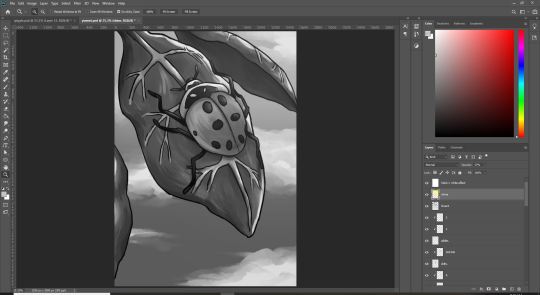
6) If you want to get better at realistic faces, I was taught using the grid system. You have squares on your reference picture, squares on your paper, and then match up the body parts to the squares. I personally didn’t like this method, but it’s a really solid style of learning.
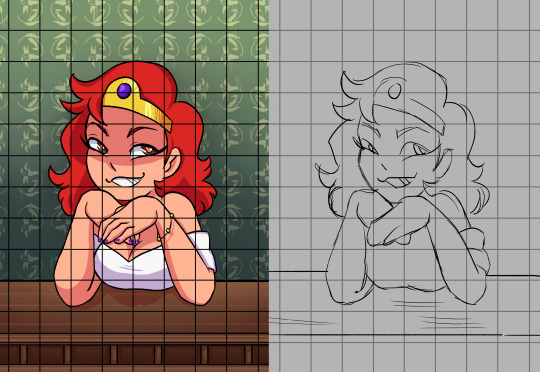
7) Start with the torso instead of the head. what you start with the head, the body may end up becoming wonky and having the neck stretched out at an odd angle or having a too small cranium. This is easier to fix in digital art but I suggest just remembering the importance of that rib cage (this is something I’m still training myself out of).

8) Asking for feedback can be an invaluable tool. For example, last year I had this really weird thing where I drew my eyes way too close together- I never noticed until I had it pointed out to me, and it took MONTHS to break this habit.

9) References are very useful, and one fun technique I’ve found great use in is to draw a pose, first with no reference, and then following that reference very strictly. This can be helpful when you want to see where you are developmentally.
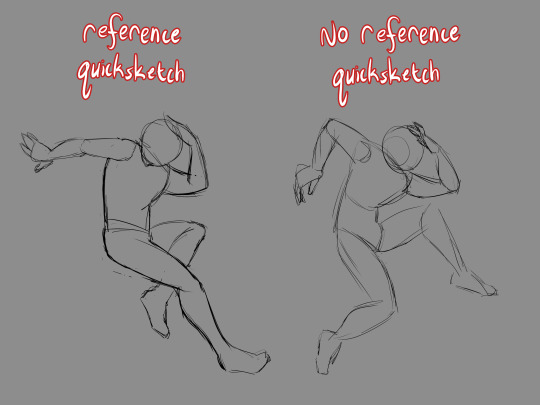
10) Every now and then while drawing, you want to put the pencil down, prop up your paper, and walk away so that you can see the full image from a distance. If you’re working digitally, you zoom out a great deal so that the image appears smaller. This is a GREAT tool for seeing which sections of the piece need the most attention and how those smaller details hold up.
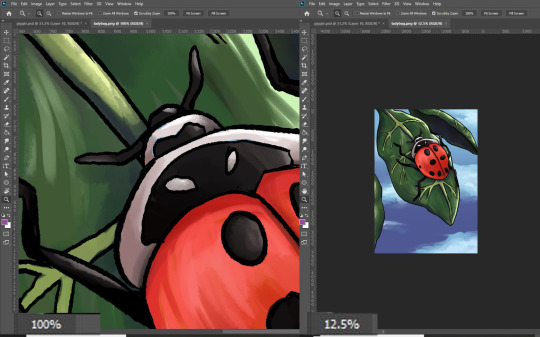
11) If you have the opportunity, you REALLY want to participate in an actual art class. Having a teacher that can see what you’re doing in real time and knows where you’re at skill-wise is an INVALUABLE thing to have- these people were specifically taught how to teach you these skills, recognize your problems and how to fix them. Don’t be afraid to talk to them and ask for advice about non-classwork art, either! You can’t receive help if you don’t ask for it.

12) Flip your canvas! I know you’ve probably heard this before, but this is one of the best ways to check for anatomy inconsistencies.
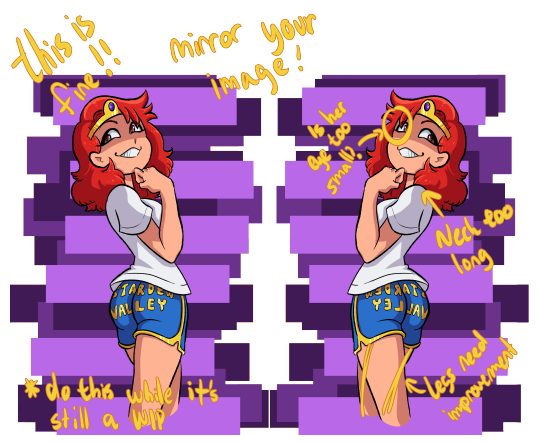
13) When it comes to youtube artists, I don’t really actively follow any, but I do know of some!
Mark Crilley: While I don’t watch his videos much now, I used to follow his videos RELIGIOUSLY. He’s got some really solid advice on how to map out comics and mangas, and he taught me the importance of silent scenes and keeping your work from getting too wordy. He mostly does the soft anime look, but he also does some pretty stellar realism.
mikeymegamega: I’m not going to lie to you, anon- this man likes his cheesecake. This guy is all about the cute anime girls, so if you’re not looking for that, skip him, but I really can’t recommend his videos on hands, feet, and faces enough.
Proko: Has a video about best drawing exorcises and is the guy you turn to when you want to know about figure drawing. He tends to focus on the more realistic anatomy, and while his videos may be long he’s got some good advice. I’d say to check out his studying anatomy correctly video, and then just kinda scroll through his pages.
Ethan Becker: THE KNIFE MAN. The first time I clicked on him I thought he was making a troll video- but then he Got Into It and my dudes, my guys, he has some CRAZY good advice. The way he words things and shows you examples in his videos are amazing and I really can’t recommend him enough. He did a video called “Fixing PROKO's LAZY Drawings“ and while you’d think it would be a bash fest his advice on shading in it is just so incredibly useful. Click on pretty much any of his videos and you’ll be entertained and learning.
I'd also suggest watching speedpaints. Even if it was unintentional, I’ve learned several really solid art hacks from speedpaint and storytime videos- so always be aware that you have an option for that.
…. Oh! And also, practice! I know you’ve probably been given this advice from everyone already, but it’s worth remembering.
Sorry if this got a bit long, I just figured I’d try to give you some good hacks- and even if you have already heard of most of these, I hope I could at the very least entertain!
119 notes
·
View notes
Text
Desert Painters of Australia at Gagosian Hong Kong
September 11, 2020

DESERT PAINTERS OF AUSTRALIA
Two Generations
Opening reception: Thursday, September 24, 5–8pm
September 24–November 7, 2020
7/F Pedder Building, 12 Pedder Street, Central, Hong Kong
__________
Whole lot, that’s the whole lot. Awelye (my Dreaming), Arlatyeye (pencil yam), Arkerrthe (mountain devil lizard), Ntange (grass seed), Tingu (a Dream-time pup), Ankerre (emu), Intekwe (a favorite food of emus), Atnwerle (green bean), and Kame (yam seed). That’s what I paint: whole lot. . . .
—Emily Kame Kngwarreye
Gagosian is pleased to announce the first-ever exhibition in Hong Kong dedicated to work by contemporary Indigenous Australian artists. It is the third in a series of critically acclaimed exhibitions presented by the gallery, following New York and Los Angeles in 2019. Desert Painters of Australia: Two Generations is organized in collaboration with D’Lan Davidson, a leading Melbourne-based consultant in the Indigenous Australian art market.
Indigenous Australians constitute the longest surviving civilization in human history for more than 60,000 years. While affinities may be perceived between remote Indigenous Australian art and other modern art forms, the individual practices that are developed in relative isolation stem from the oldest continuous art traditions in the world.
This exhibition is designed to introduce the local audience for the first time to rare works by some of Australia’s most renowned Indigenous artists from remote regions of the continent. The intergenerational selection includes the late Emily Kame Kngwarreye, Makinti Napanangka, and Bill “Whiskey” Tjapaltjarri, and living artists such as Yukultji Napangati, George Tjungurrayi, and Warlimpirrnga Tjapaltjarri.
After the forced displacement of the Pintupi, Luritja, Warlpiri, and Arrernte people to the Papunya settlement in the Northern Territory from the 1950s, tribal members began collaborating on site-specific paintings. Deriving from ancient rituals of body decoration, sand drawing, bark carving, and ceremony dance, these collective expressions eventually evolved into autonomous works on canvas by individual artists. To protect the rituals of their culture from disruptive forces, the artists veiled their sacred iconography and knowledge in dynamic abstract patterns, decipherable only by initiates. Their intense focus and rhythmic mark making produced compelling works of great optical complexity—pointillist constellations, free-flowing linear formations, concentric swells, topological geometric fields, and hypnotic ripples—representing the Dreaming, a worldview that provides Indigenous Australians with an ordered sense of reality, a framework for understanding and interpreting the world and the place of humans in that world. This priceless knowledge of human life includes survival strategies, ancestral histories, and narratives of the earth and the cosmos.
Emily Kame Kngwarreye, affectionately known as “Emily,” was a revered elder of the Utopia region and one of the most celebrated artists in Australian history. Throughout the brief ten-year span before her death, she painted freely and prolifically, moving confidently through an astonishing range of style and expression. Anooralya—My Story (1991) is a key example of Emily’s early “fish-eye” pointillist technique, where she engaged her entire body in making countless individual marks on canvas. In this painting, rarely seen in the last thirty years, these delicate dots coalesce into grainy pools and sinuous streams, recalling at once the macrocosmic systems of the galaxy and the microcosmic root structures of the wild yam, a symbol of fertility and Emily’s Dreaming. When asked to describe her inspirations, Emily’s response was consistent: “It’s everything.” In other words, each painting represents her entire culture, encapsulating her intimate relationship with “Country,” the physical land and the spirits that inhabit it, as well as the people and their traditions.
Makinti Napanangka’s paintings commemorate Pintupi women’s performative and ritual traditions. The flowing stripes of paint in amber and violet recall the nyimparra (hand-spun string skirts made from human hair) and the rich natural ochres with which the women adorn their bodies during tribal dance ceremonies. Makinti’s pulsating compositions draw from Pintupi epics, especially the travels of Kungka Kutjarra (two women ancestors) who created the landforms at Lupulnga. In the featured works, expressive lines of color evoke the energetic movements of the hair-string skirt dances and the fleeting desert mirages that glaze the hot earth where they are performed.
For generations, the land and the many stories it contains have inspired the creativity of the Desert Painters as seen in the dizzying labyrinths and energetic fields by George Tjungurrayi and Warlimpirringa Tjapaltjarri. Transmuting into paint on canvas the customary mark-making techniques with which they decorated their tools and their bodies with ceremonial designs, these Pintupi men trace sinuous lines into charged and tensile optical compositions. While Tjungurrayi’s paintings are generally flame-colored to evoke sun and earth, Tjapaltjarri uses restrained gray pigments to evoke the sensations of cool desert nights from Tingari epics. Many of Tjapaltjarri’s paintings evoke Wilkinkarra (Lake Mackay), a vast saltwater flat visited after dark by ancestral women to perform sacred celestial rituals. Yukultji Napangati, sister to Warlimpirringa, was also born near Wilkinkarra at a water hole called Murruwa. In her highly refined paintings, she layers thousands of tone-on-tone vertical strokes to generate oscillating fields of dark and light sensation that recall the shimmering grasslands, the fractal patterns of sand dunes, and the textures of animal pelts from her Country.
Bill “Whiskey” Tjapaltjarri, a Pitjantjatjara artist from the Western Desert, used a unique cartographic approach to paint works of sweeping scale that are reminiscent of drawings his elders once made with crayon on butcher’s paper to map the vast lands of their Country for white anthropological interlocutors. Two of Whiskey’s largest paintings, both titled Country and Rockholes near the Olgas (2006) depict the areas around Uluru (Ayers Rock) and Mount Olga. The subtle palette of these works, which ranges from deep aqueous blues to vivid corals, and their complex contouring, reimagine the striking hues and topography of the geological phenomena that surrounded Whiskey throughout his life.
THE ARTISTS:
Emily Kame Kngwarreye (c. 1910–1996), an elder of the Anmatyerre tribe and arguably the most famous Indigenous Australian artist, began painting at a late age in the Alyawarra community of Utopia. She is celebrated for her rapid and systematic exploration of different styles and formal inventions, largely identified with women’s ritual activities. Her early dot paintings drew on her experience with traditional batik fabric production; over time, her paintings became more and more gestural, reduced in their detail and liberated in their formal qualities. Emily has been the subject of major museum surveys in Australia and Japan, and her work featured prominently in the 56th Biennale di Venezia in 2015.
Makinti Napanangka (c. 1930–2011) was born at Mangarri, near the Kintore community, on the border of the Northern Territory and Western Australia. She lived in the Haasts Bluff community before moving to Papunya, where she began her prolific painting career. In 1999, Napanangka underwent a cataract operation, which led to the evolution of the thick expressive lines and more vivid hues that characterize her mature painting style.
Yukultji Napangati (born 1975) left her traditional hunting-and-gathering life in 1984 as a member of the “Pintupi Nine,” one of the last Indigenous groups to move into contact with modern Australian society. Drawing on ancestral narratives or Dreamings passed down to her through generations, her distinctive style involves intense and refined mark making on large canvases to produce astonishing optical sensations related to natural phenomena.
George Tjungurrayi (born c. 1947), a member of Papunya Tula, is deeply invested in his Pintupi heritage, particularly the stories of the Tingari cycle from his Country. Tjungurrayi has developed an abstract language that sublimates the details of his relationship to these sacred places and their information into dynamic linear compositions painted in simple and precise lines, rather than fused dots. He has been represented in solo exhibitions in Australia and the Sydney Biennale, where a suite of his paintings was exhibited both on the ground and on the wall.
Warlimpirrnga Tjapaltjarri (born c. 1958) is a member of the “Pintupi Nine.” He started painting in acrylics in 1987, after observing his relatives painting in the remote community of Kiwirrkura in Western Australia, where the cooperative of Papunya Tula artists had become well established. Tjapaltjarri’s earliest paintings were purchased and donated to the National Gallery of Victoria in Melbourne. Since that time he has also participated in such major exhibitions as documenta 13, in Kassel, Germany.
Bill “Whiskey” Tjapaltjarri (c. 1920–2008) was a renowned ngankari (healer), nicknamed for his abundant whiskers. He was born at Pirupa Akla, near the Olgas, and lived in the Haasts Bluff community near Mount Liebig in the Northern Territory. He began painting at eighty-five and continued until his death four years later. His paintings have been exhibited throughout Australia as well as in Europe and Asia.
ABOUT D’LAN DAVIDSON:
Working as a private dealer and an auction house expert for fifteen years before opening his solo enterprise in Melbourne five years ago, D’Lan Davidson has produced exhibitions and catalogues of exceptional remote Indigenous Australian art in Australia and the United States. D’Lan Contemporary operates under a strict ethical policy, exhibiting all works with a clear line of community art center provenance and assisting economic growth for Indigenous Australian communities with the establishment of his Voluntary Resale Royalty initiative, which invites sellers to contribute 2.5 percent of their resale proceeds back to the respective artist or estate and then matches their contributions.
_____
Emily Kame Kngwarreye, Anooralya–My Story, 1991, synthetic polymer on linen, 48 × 84 inches (121.5 × 213 cm) © Emily Kame Kngwarreye/Copyright Agency. Licensed by Artists Rights Society (ARS), New York, 2020
19 notes
·
View notes
Note
Hey Rox, random question. How can one learn to draw? I mean, I got the whole take a pencil and a paper and practice everyday but I mean, after doing that you understand proportions, light, perspective? Naturally? Just by practicing everyday?
Artists telling people just to practice art and not giving them any solid starting place is a bullshit cop-out and something I’ve probably said at some point, but I’m going to rectify it now by giving you a comprehensive guide to starting art.
Some people may disagree with me (and honestly I recommend asking other artists this same question to see what they say and what you yourself agree with), but I think no matter what kind of 2D art you want to make, you should start with traditional, realistic drawing or painting. The reason for this (aside from anecdotal evidence of it working for me) is that learning to draw things that occur in real life gives you a foundation for branching out into different styles or media down the line. Even if you want to draw cartoons or anime, learning realistic drawing will help you, because it will familiarize you with the complicated shapes that more cartoony drawings simplify or exaggerate. For example, if you learn to draw a realistic nose, then you can see different ways to turn that realistic shape into a simplified version of itself. Practicing realistic art can also help train your eye and get you accustomed to different techniques such as line quality, shading, color theory, composition, and various types of art materials, or media, as I will probably begin referring to it as.
So, the next step is to figure out how the hell to start learning to draw realistic stuff. I will help, using written descriptions, tips, and videos I have found online to help you.
First off is Materials/Media.
You can make art with practically anything. Anything from the humble paper and pencil to the most expensive and high-end art supplies. You can burn a piece of wood in a fire for a bit and then use the charred end to make marks with. You can use mud to paint with. You can dip your toe in ink and use that as a paintbrush. My point is that you can really get creative with it and I think creating art should be a joyful experience, not a painful one.
Art supplies can be very expensive, so for beginners I really do recommend a paper and pencil. Not a mechanical pencil either, but one of those wooden ones. They work well for drawing because you can use both the point and the side of the lead to make marks with. I also recommend getting a good eraser. My favorite kind are the grey kneadable ones, because you can squish them into any shape you need for any particular area that needs erasing. I’ll link to some on Amazon later on.
You can practice pencil drawings on lined paper (I have a whole lot of sketches I did in high school that are just on lined paper), printer paper, cardboard, etc, or you could invest in a sketchbook. Cheap sketchbooks are pretty easy to find, like they have them at my local grocery store, but you can also find them online for fairly cheap. Sketchbooks are made of different paper depending on the media (drawing materials) that you’re using. Paper intended for pencil drawings tends to have quite a fine grain for smooth blending, whereas paper in watercolor sketchbooks is rough and absorbent to suit the wet medium. You can get a sketchbook with any paper you want, really. I’ve done pencil drawings on pastel paper before, because it was the only paper around, and it still looked nice, just different than it would on finer grain paper. What materials you choose to use depends on the look you’re going for, and you’ll figure that out more with experience.
To start with, just grab some paper and a pencil and start making marks on it. See how many different looking marks you can make on the paper. I’m not really talking about shapes persay, but literal marks with the pencil. Thin lines, thick lines, scribbles with lots of pressure or just a little bit of pressure. Scrape the side of the pencil along the paper and see what it does. Try blending the lines with your finger. Just take some time to play with the material without getting hung up on creating anything. Do this sort of experimenting with any new art material you’re introduced to. The first thing you should do with a new tool is acquaint yourself with it, and that’s what this is doing. Get used to how the pencil feels in your hand and what motions feel comfortable with it. Keep in mind that you don’t have to hold the pencil the same way as if you were writing. Often if I’m shading with a pencil, I will hold it with all of my fingers around it and use my thumb to put pressure on it.
Now, shading.
Shading and mark making go together, because shading is basically using the marks you’re making with your pencil or pen to indicate lightness vs. darkness. To practice mark making and the techniques that are used for shading, I recommend watching this video and drawing along with the exercise. The artist uses pens in it but you can do it with pencil too!
When you’re ready, you can start trying to shade basic forms (shapes). Shading gives a two dimensional shape a three-dimensional look. It turns a flat circle into a sphere. Once you learn how to shade basic shapes, you can pretty much figure out how to shade just about anything. For example, once you learn how to shade a sphere, you know how to roughly shade a head! And what is an arm if not a cylinder? A nose if not a pyramid?
There are lots of videos online for practicing this. Here’s one that’s pretty good.
This is where I recommend starting. Once you are more comfortable with that, here is a list of things that you can look up and try to get a handle on, in what I think is a pretty alright order.
Perspective (one-point, two-point, three-point)
Value, Tint, Shade
Drawing negative space
Foreshortening
Composition
Drawing from life
Color theory
It would take me a very long time to outline all of this stuff, which is why I’ve given you that list of stuff to look for online. There are a lot of great resources out there and I recommend searching for them and comparing them. I can’t go into depth on everything right now because there’s a LOT of stuff, but I hope the little outline I gave you will help give you a foundation and know where to look and what to look for! If you have any questions about specific stuff, feel free to come and ask me about it and I’ll try to help.
Here are links to some cheap art materials on Amazon:
Grey kneadable eraser
Sketchbook for pencil
Pen set
There are lots of other listings for stuff like this online, so do check around for what you want! The ones I linked are just options.
I hope this helped! Thank you for the ask anon, and good luck!
#ask box#anon#art tips#art instruction#long post#beginning art#sorry i petered out at the end it's just i'm so fuckin hungry rn#i'm about to lose my mind i haven't eaten all day like an idiot#Anonymous
12 notes
·
View notes
Text
Artist Sam Winchester Headcanon
Disclaimer: I don't own Sam or Dean or Supernatural. I only own a copy of the Men of Letters Beastiary book that inspired this.
Sam started off by drawing little doodles in the margins of his notes as a kid. He continued drawing in school, taking art classes whenever he had the option. By the time he went to Sanford, Sam was great at drawing figures. He loved doing ink drawings with different pens.
Sam started doing commissions to make some extra money. He saved up enough to get a full calligraphy set and some nice paper. Sam did some calligraphy writing, but he preferred drawing.
Even when he was back into hunting, he kept drawing. Sometimes he would scribble absent-mindedly on his notes or scraps of paper. Sometimes he would go all out and make beautiful portraits.
As much as he loved drawing figures, he missed playing around with the various calligraphy tips. Sam wanted to buy a new set for quite a while. But the little calligraphy nibs would either be lost, broken, destroyed on accident, thrown away, or cast into bullets.
This pushed Sam to work work graphite and charcoal. Graphite looked nice, and charcoal was easy to make. He kept his drawings in a little sketchbook he bought at a book store. It kept the charcoal from getting all over Dean's car and kept the drawings from getting too smudged.
Once the brothers moved into the bunker, Sam took a chance and bought a new calligraphy set to keep in his room. He thought he would be a bit rusty from years without practice. Sam was pleasantly surprised to remember how to hatch, cross-hatch, stipple, and all the other drawing techniques.
Sam bought a new sketchbook that was a bit bigger and had better paper. Now that he and Dean weren't moving around so much, Sam could make bigger drawings and experiment with more mediums like colored pencils, oil pastels, water color, and acrylic. He enjoyed colored pencils the most because of how much detail he could put into a piece, but ink was still his favorite.
Sam didn't show Dean his drawings. As much as he loved his brother and as proud as he was of his work, his art was private. It was something he could do for his own enjoyment without worrying what others would think of it or want him to do.
The trouble is, Dean has a bad habit of just busting into Sam's room without knocking if he's excited about something. Whenever Sam works on a large drawing, he keeps his door closed and puts a towell or a blanket to block light getting out. That way, Dean would assume he was asleep.
Sam had a few close calls. He'd once walked into the kitchen with a big smear of charcoal on his face. He told Dean it was from trying to reach something behind a dusty cabinet. Usually, it was nothing more than a few stains of ink or paint on his hands that he could easily hide.
Despite his efforts, Dean still came really close to finding out. Sam had just finished a large watercolor and colored pencil piece of a beautiful garden. He cleaned up and put everything away minus the picture. Dean burst into Sam's room moments later to announce that he found a hunt.
The picture caught his eye immediately.
"Whoa... Did you make that?" He asked.
Sam let out something between a chuckle and a gasp. "Uhm... No. No it's something I bought from a local artist. What's the case, Dean?"
Dean knew Sam was lying. He just wasn't sure why. The artwork was stunning. From his angle, it looked like a photograph. For now, Dean would stay quiet and try to get some answers later.
For the next month, Sam did whatever he could to throw off his brother's suspicions. He pretended to "sketch" what a witness said about their attacker, only to show a juvenile doodle, complete with little sticks as hair.
Sam made sure he had absolutely no traces of his mediums on his hands or face when he left his room. He also hid his work in a more secure location where Dean wouldn't look.
A couple months later, Dean surprised Sam by asking about the artist Sam bought the painting from. "Just think the bunker could use something colorful since it's so grey."
Sam pretended to keep chewing his food to get out of answering the question. He settled with "The artist moved away a couple months ago. I got the piece from a moving sale."
Dean let his fork drop onto his plate with a loud clatter. He gave Sam his best bitch-face and sighed. "I know you made that piece, Sammy. I've known for a while. You've been drawing since you could hold a friggin' crayon! Why did you lie to me?"
Sam looked anywhere but at his brother.
"Sam?"
"I didn't wanna draw monsters," Sam admitted.
Dean raised an eyebrow. "Why d'ya think you'd have to draw them?"
"Some of my work looks pretty realistic and it would be useful to have accurate references for the things we hunt. I thought if I said anything, you'd ask me to make them," Sam answered. "I just wanna do something that doesn't involve hunting or monsters."
They sat in silence for a moment that felt like an eternity.
"I'm not gonna make you draw monsters, kiddo. I never even considered it. You gotta have somethin' that you do just for you," Dean assured.
Sam finally looked up. "You're not mad?"
"I'm a little ticked you thought you had to hide this, but I'm not mad. Just... no more lyin'."
After their talk, Sam stopped trying to hide his art. He showed Dean some of his paintings since they had the most color. They bought some picture frames and scattered them throughout the bunker halls.
There was one drawing that Sam really wanted Dean to have: an ink drawing of the Impala from different angles. One of those pictures included Dean looking into the hood of the Impala to fix her up.
Sam didn't say anything about it. He had it framed, then set the picture on Dean's desk.
Dean moved the picture to his bedside table, where he would see it first thing in the morning and last thing at night. He might've also made it his wallpaper on his phones and laptop but Sam doesn't need to know.
Edit: Fixed some typos.
1 note
·
View note
Text
Mary Catherine Bateson Dies at 82; Anthropologist on Lives of Women

Mary Catherine Bateson, a cultural anthropologist who was the author of quietly groundbreaking books on women’s lives — and who as the only child of Margaret Mead had once been one of the most famous babies in America — died on Jan. 2 in Dartmouth, N.H. She was 81.
Her husband, J. Barkev Kassarjian, confirmed the death, at a hospice facility. He did not specify the cause but said she had suffered a fall earlier that week and experienced brain damage.
Dr. Bateson’s parents, Dr. Mead and Gregory Bateson, an Englishman, were celebrated anthropologists who fell in love in New Guinea while both were studying the cultures there. (Dr. Mead was married to someone else at the time.) They treated their daughter’s arrival almost as more field work, documenting her birth on film — not a typical practice in 1939 — and continuing to record her early childhood with the intention of using the footage not just as home movies but also as educational material. (Dr. Bateson’s first memory of her father was with a Leica camera hanging from his neck.)
Benjamin Spock was her pediatrician — she was Dr. Spock’s first baby, it was often said — and his celebrated books on child care drew from lessons learned by Dr. Mead.
Still, it wasn’t her babyhood, her lineage or her scholarship — an expert on classical Arabic poetry, she was as polymathic as her mother — that brought Dr. Bateson renown; it was her 1989 book “Composing a Life,” an examination of the stop-and-start nature of women’s lives and their adaptive responses — “life as an improvisatory art,” as she wrote.
In the book, Dr. Bateson used her own history and those of four friends as examples of ambitious women at midlife. (She was 50 at the time of its publication.) All five had lived long enough to have experienced loss, the strains of motherhood, sexism, racism, career setbacks and betrayals. In Dr. Bateson’s case, she had been ousted as dean of faculty at Amherst College in Massachusetts in an apparent back-room deal orchestrated by male colleagues. It left her hurt at first; her anger would take years to blossom.
Jane Fonda hailed Dr. Bateson’s 1989 book as an inspiration, as did Hillary Clinton, who as first lady invited Dr. Bateson to advise her.
Written with wry compassion and a behavorial scientist’s sharp eye, the book became in its way an unassumimg blockbuster and a touchstone for feminists. Jane Fonda hailed it as an inspiration, as did Hillary Clinton, who as first lady invited Dr. Bateson to advise her.
“Reading ‘Composing a Life’ made me gnash my teeth and weep,” the author and Ms. magazine co-founder Jane O’Reilly wrote in The New York Times Book Review in 1989. “I scribbled all over the margins, turned down every other page corner and underlined passages with such ferocity that my desk was flecked with broken-off pencil points.”
The insights in the book, Dr. Bateson wrote, “started from a disgruntled reflection on my own life as a sort of desperate improvisation in which I was constantly trying to make something coherent from conflicting elements to fit rapidly changing settings,” as if she were rummaging frantically in the fridge to make a meal for unexpected guests.
dMary Catherine Bateson was born on Dec. 8, 1939, in New York City. Her father was in England at the time; an avowed atheist, he sent his wife a congratulatory telegram instructing, “Do Not Christen.”
Mary Catherine was reared according to the rituals and practices her parents had observed in their fieldwork, including being breastfed on demand; her mother would consult with Dr. Spock. So committed was Dr. Mead to record-keeping that when Mary Catherine was in college and wanted to throw out her childhood artwork, her mother declared that she had no right to do so.
Mary Catherine grew up in Manhattan, mostly in the ground floor apartments of two townhouses in Greenwich Village that Dr. Mead shared in succession with friends who lived on the upper floors. As Dr. Mead was often away from home for work — or, when at home, working full-time — it was a convenient living arrangement: Mary Catherine could be looked after when necessary by a full bench of unofficial siblings and their parents, as well as an English nanny and her adolescent daughter.
Dr. Mead’s housekeeping techniques were also novel: When home, she cooked and ate dinner with her daughter but eschewed dishwashing, so as not to waste time that could be better spent with Mary Catherine or on her work. Day after day, dishes piled up in dizzying verticals “like a Chinese puzzle,” awaiting a maid who would arrive on Mondays, as Dr. Bateson recalled in an earlier book, “With a Daughter’s Eye: A Memoir of Margaret Mead and Gregory Bateson” (1984).
The memoir is an affectionate yet sober portrait of two very complicated people. “One of the premises of the household in which I grew up,” Dr. Bateson wrote diplomatically, “was that there was no clear line between objectivity and subjectivity, that observation does not preclude involvement.”
In his review of the book in The Times, Anatole Broyard noted that Dr. Bateson had brought “almost as much sophistication to bear on the picture of her childhood and her parents as they did on her.”
“We are used to novelists and poets giving us their highly colored or hyperbolic versions of their fathers and mothers,” he went on, “but Miss Bateson, who was born in 1939, is a behavioral scientist as well as a writer with considerable literary skill.”
Her parents were married for 14 years before divorcing. Dr. Mead died in 1978 at 76. Gregory Batesman died in 1980 at 76.
Mary Catherine attended the private Brearley School in Manhattan. At 16, after accompanying her mother on a trip to Israel for one of Dr. Mead’s lectures, she stayed behind and spent part of that year on a kibbutz, where she learned Hebrew. Over the years she would also learn classical Arabic, Armenian, Turkish, Tagalog, Farsi and Georgian, the latter because she thought it would be fun.
She entered Radcliffe at 17, studied Semitic languages and history, and graduated in two and a half years. She had already met Dr. Kassarjian, a Harvard graduate student at the time, but promised her mother that she would not marry until she finished college. She earned her Ph.D. in linguistics and Middle Eastern languages at Harvard in 1963; her husband earned his there in business administration.
Early in their marriage, she and Dr. Kassarjian lived in the Philippines and then Iran, following his career running Harvard-related graduate institutes in those countries. Dr. Bateson found work as an academic and an anthropologist, learning Tagalog in the Philippines and Farsi in Iran to do so. They lived in Iran for seven years, until they were forced out in the late 1970s by the revolution there, having to leave most of their possessions behind.
Dr. Bateson taught at Harvard, the Massachusetts Institute of Technology, Brandeis University and Spelman College in Atlanta, among other institutions. At her death, she was professor emerita of anthropology and English at George Mason University in Virginia and a visiting scholar at the Center on Aging & Work at Boston College.
Her husband is a professor emeritus of management at Babson College in Wellesley, Mass., and professor emeritus of strategy and organization at the International Institute for Management Development in Lausanne, Switzerland.
Dr. Bateson published a number of books on human development, creativity and spirituality, including “Composing a Further Life: The Age of Active Wisdom” (2010).
In addition to her husband, she is survived by their daughter, Sevanne Kassarjian; her half sister, Nora Bateson; and two grandsons.
At her death, Dr. Bateson was working on a book titled “Love Across Difference,” about how diversity of all stripes — gender, culture and nationality — can be a source of insight, collaboration and creativity.
Multiple Service Listing for Business Owners | Tools to Grow Your Local Business
www.MultipleServiceListing.com
from Multiple Service Listing https://ift.tt/3ipCxGx
2 notes
·
View notes
Text
Portraiture
Group practical
we sat parallel to another person, we had our pencils stabbed through paper so we could not see the paper below and we had to focus only on the face and not look down, basically a blind drawing as far as looking at the drawing but we could see what the object was as we drew it.

i did the same thing again in graphite and had got a better understanding of proportion considering we could not see the drawing.
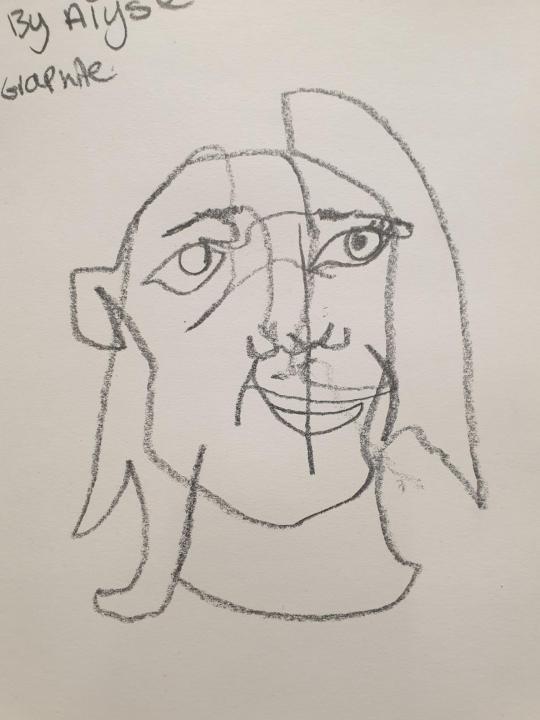
we then chose a unique image of ourselves, well mine was rather unique and we did a rough sketch to help us decide what we wanted to draw for our social realism drawing, i was quite impressed by my sketch the proportions were not half bad.
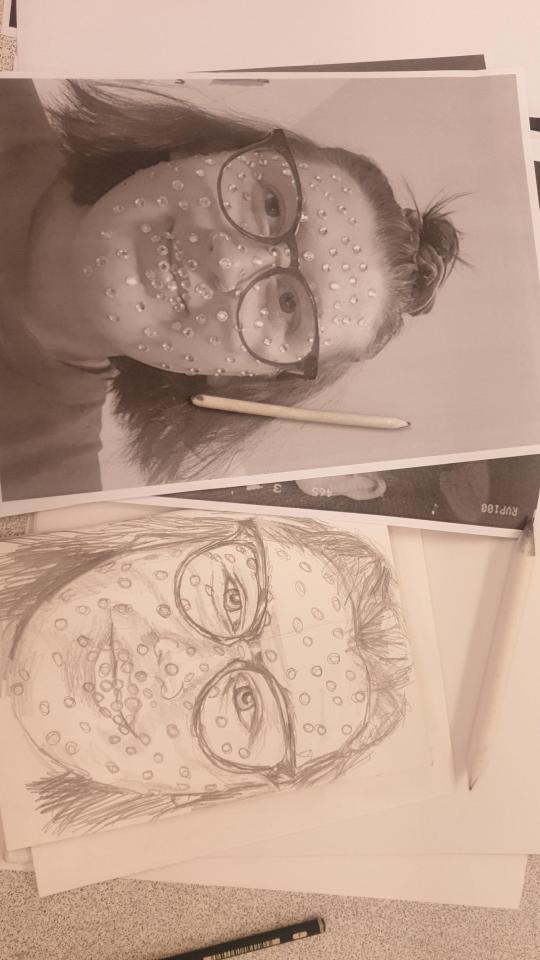
photo REALISM
i chose to just do the center of my face as i felt it would look the best in the social realism style, i then grid my drawing in 4 by 5 squares and did the same to my paper before then beginning my drawing of the outline and basic shapes in order for me to add tone and texture later on
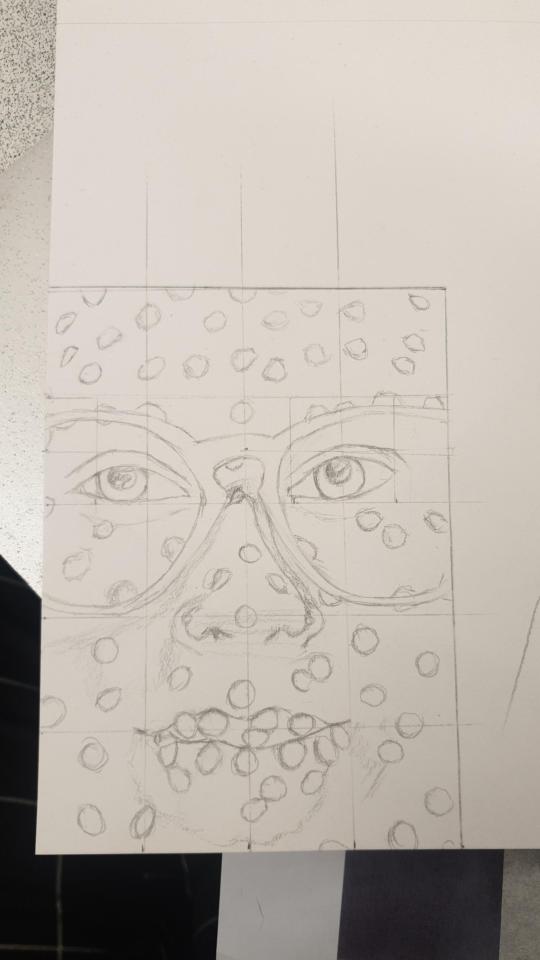
what is photo realism?
photo realism is a form of art where a drawing or painting looks absolutely identical to the object or photo it has been drawn from, so much so you cant tell the difference between the two, it takes time, patients and a lot of skill.
but most of the art community don’t consider this to be an art form.
Many would argue that the technical skill required to make Photorealism art can be exceeded by a decent color photocopier or a computer, thus avoid to use the word art in such context, but this discussion brings us to an analogy of photography. If photography is merely capturing an image of what is already there, where is the art in that? It is right there in the photographer’s perspective, the exact choice made by the person wielding the camera in what to capture and from which angle, moment and perspective. If a person creating a photorealistic recreation of a photograph doesn’t have that “artistic” input of a photographer, then what is artistic about the process? Some would say even those renditions are not strict interpretations of photographs, instead, they incorporate additional, often subtle, pictorial elements to create the illusion of a reality which does not actually exist, or cannot be perceived by the human eye.
In the end, as in many things in art, and life in general, the final conclusion remains behind the individual perspective
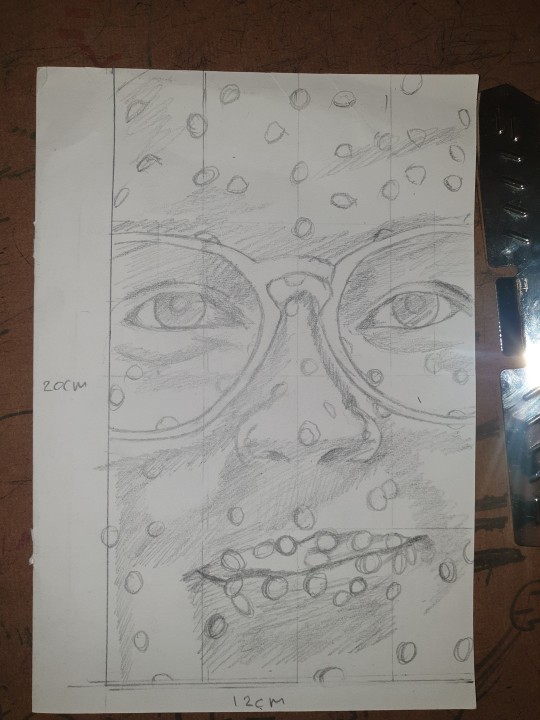

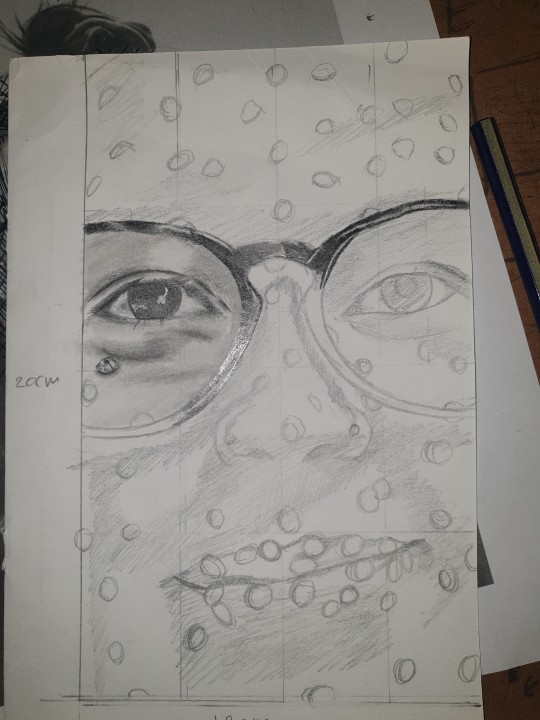
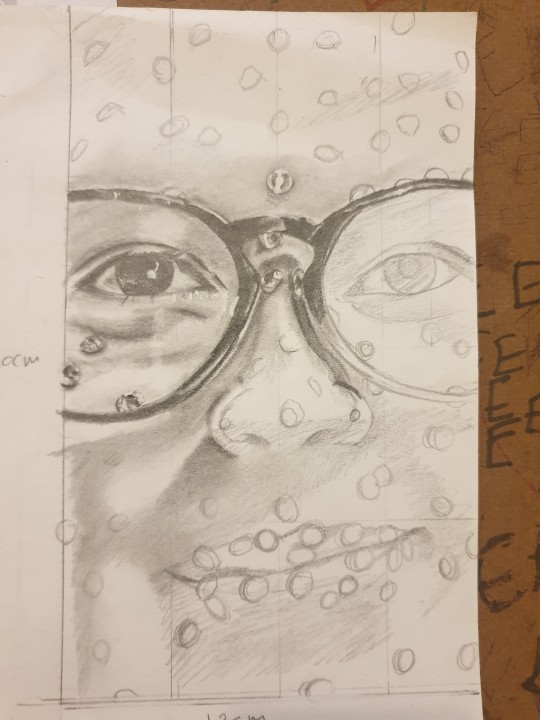
Da Vinci
Long recognised as one of the great artists of the Renaissance, Leonardo da Vinci was also a pioneer in the understanding of human anatomy. Had his ground-breaking work been published, it would have transformed European knowledge of the subject.
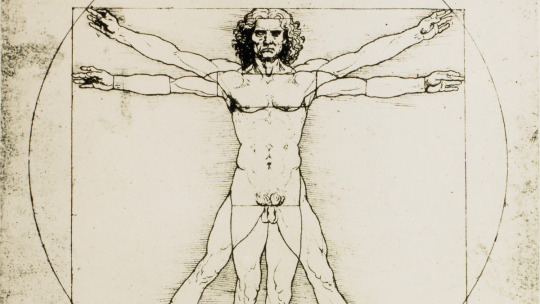
https://www.rct.uk/collection/themes/exhibitions/leonardo-da-vinci/the-queens-gallery-palace-of-holyroodhouse/explore-the-exhibition#/
At the outset of Leonardo’s career, anatomical illustration was in its infancy. To convey the three-dimensional form of the body and to show how it moves, Leonardo had to develop a whole range of new illustrative techniques. His challenges were in many ways the same as those faced by anatomists today, and some of Leonardo’s drawings are remarkably similar in approach to modern medical imagery, such as MRI and CT scans and 3D computer modelling.
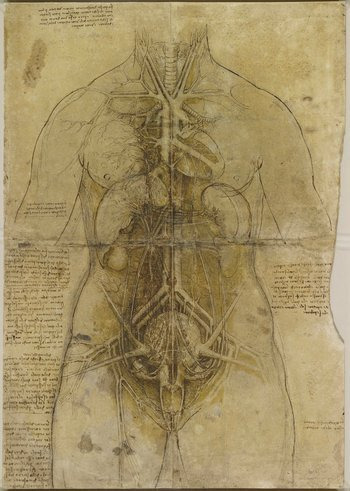
Studies of Human Proportion
While studying Vitruvius for his work on the Milan and Pavia cathedrals, Leonardo became captivated by the ancient Roman architect’s detailed studies of human proportions and measurements. In addition, when he was measuring horses for the Sforza monument, he became interested in how they related to human proportions. Comparative anatomy appealed to his instinct for finding patterns across different subjects. So in 1490 he began measuring and drawing the proportions of the human body.
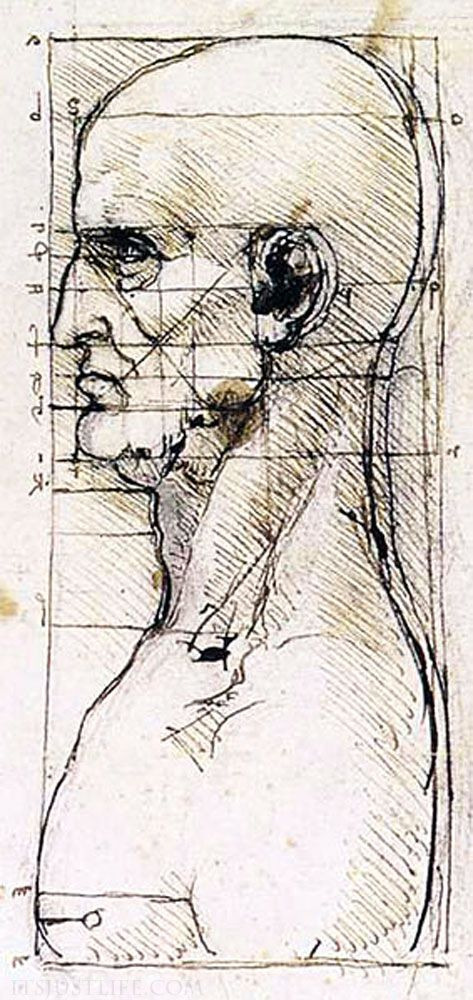
The construction lines and all of the annotation almost take away from the actual subject and become more of the focus, which was the main idea anyway It was not meant to be a work of art, but rather a manual for how to create it.
Da vinci was a polymath, a person of wide knowledge or learning. He was not only an artist but a scientist, sculpture and an architect.
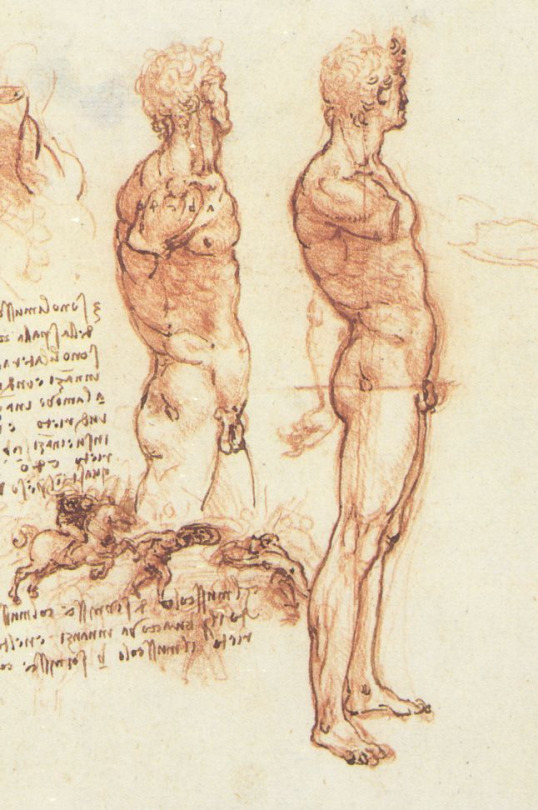
Frida Kahlo
was a Mexican painter known for her many portraits, self-portraits, and works inspired by the nature and artifacts of Mexico. Inspired by the country’s popular culture, she employed a naïve folk art style to explore questions of identity, postcolonialism, gender, class, and race in Mexican society. Her paintings often had strong autobiographical elements and mixed realism with fantasy. In addition to belonging to the post-revolutionary Mexicayotl movement, which sought to define a Mexican identity, Kahlo has been described as a surrealist or magical realist.

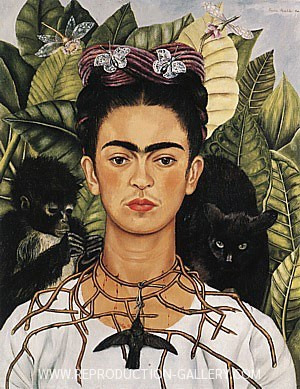
Kahlo’s paintings often feature root imagery, with roots growing out of her body to tie her to the ground. This reflects in a positive sense the theme of personal growth; in a negative sense of being trapped in a particular place, time and situation; and in an ambiguous sense of how memories of the past influence the present for either good and/or ill.[110] In My Grandparents and I, Kahlo painted herself as a ten-year holding a ribbon that grows from an ancient tree that bears the portraits of her grandparents and other ancestors while her left foot is a tree trunk growing out of the ground, reflecting Kahlo’s view of humanity’s unity with the earth and her own sense of unity with Mexico.[111] In Kahlo’s paintings, trees serve as symbols of hope, of strength and of a continuity that transcends generations.[112] Additionally, hair features as a symbol of growth and of the feminine in Kahlo’s paintings and in Self Portrait with Cropped Hair, Kahlo painted herself wearing a man’s suit and shorn of her long hair, which she had just cut off.[113] Kahlo holds the scissors with one hand menacingly close to her genitals, which can be interpreted as a threat to Rivera – whose frequent unfaithfulness infuriated her – and/or a threat to harm her own body like she has attacked her own hair, a sign of the way that women often project their fury against others onto themselves.[114] Moreover, the picture reflects Kahlo’s frustration not only with Rivera, but also her unease with the patriarchal values of Mexico as the scissors symbolize a malevolent sense of masculinity that threatens to “cut up” women, both metaphorically and literally.[114] In Mexico, the traditional Spanish values of machismo were widely embraced, and as a woman, Kahlo was always uncomfortable with machismo.[114]

image taken at the MoMa in Nyc
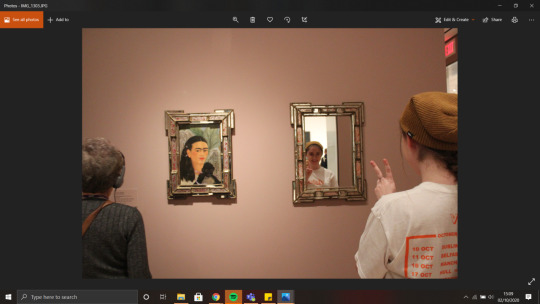
Fulang-Chang and I depicts Kahlo with one of her pet monkeys, interpreted by many as surrogates for the children she and Diego Rivera were unable to conceive. The painting was included in the first major exhibition of her work, held at Julien Levy Gallery in New York in 1938. In the essay that accompanied the show, the Surrealist leader André Breton described Kahlo’s work as “a ribbon around a bomb” and hailed her as a self-created Surrealist painter. Although she appreciated his enthusiasm for her work, Kahlo did not agree with his assessment: “They thought I was a Surrealist but I wasn’t. I never painted dreams. I painted my own reality.” Kahlo later gave this painting to her close friend Mary Sklar, attaching a mirror to it so that, if Sklar chose, the two friends could be together.
Tai Shan Schierenberg
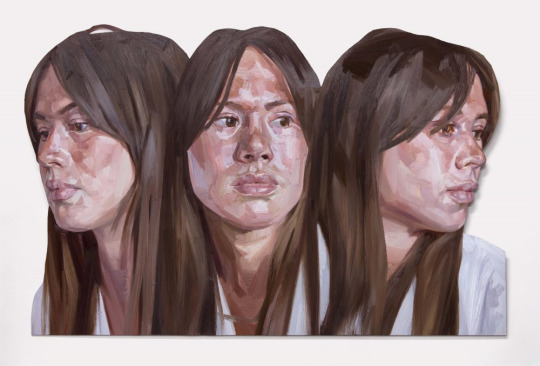
Tai Shan Schierenberg lives and works in London. He graduated from the Slade School of Art in 1987 and in 1989 won first prize in the National Portrait Gallery’s John Player Portrait Award. He was then commissioned to paint Sir John Mortimer for the Gallery. The National Portrait Gallery also holds his portraits of Lord Carrington from 1994, Lord Sainsbury, 2002 and most recently Seamus Heaney from 2004. Other noted commissions include Professor Stephen Hawking, Sir John Madejski and a double portrait of Queen Elizabeth II and the Duke of Edinburgh.
For Schierenberg, there is an emotional charge that comes from the different textures and densities, and ultimately the light conditions, that occur in a place at a certain time. He describes his process in 2010:
Painting and painting and painting, endlessly exploring ideas in paint on canvas, always painting my way. Finding that over time I can’t see the trees for the paint. Sometimes its good to try a new way, a different path, expose oneself to the vagaries of chance - and see the trees again.

Before he finishes a commission, Tai-Shan Schierenberg usually splatters a bit of paint in the corner of the portrait. It’s not a stylistic move – the brushstrokes in his paintings are fluid but the images themselves are representative – but rather one which gives the subject something to complain about.
in the image above you can clearly see the texture and markings on the canvas, the artist uses oil paint on canvas and applies it using a pallet knife and a large brush, making various large strokes in the work. this gives a rough texture and edge to the piece.
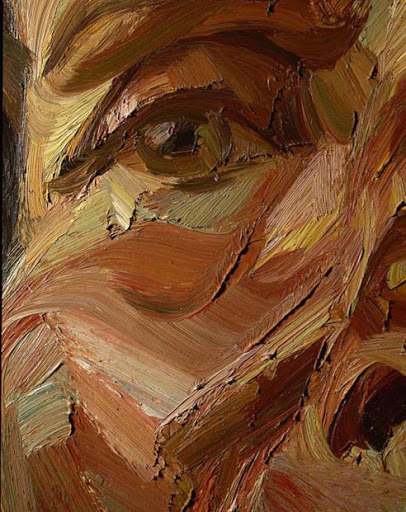
These instinctive visual images refuse to betray the plasticity of the medium. Unlike Freud, Schierenberg sees paint simultaneously as flesh. It is exactly this technique that establishes the major paradoxes characteristic of his work. It is both abstract and realist, edgy and sensitive, grand and inconclusive, violent and melancholic, physically intense and aesthetically detache

Lucian Freud
was influenced by surrealism, but by the early 1950s his often stark and
alienated paintings tended towards realism. Freud was an intensely
private and guarded man, and his paintings, completed over a 60-year
career, are mostly of friends and family. They are generally somber and
thickly impastoed, often set in unsettling interiors and city scapes.
The works are noted for their psychological penetration and often
discomforting examination of the relationship between artist and model.
Freud worked from life studies, and was known for asking for extended
and punishing sittings from his models.
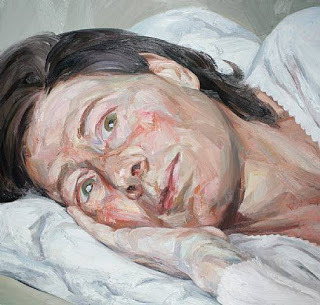
one of my chosen artists, tai shan sheirenberg seems to be heavily influenced by the style of lucian freud yet he made his own style, they both use the same meduims, oil on canvas also.
here in the colder tones we have a painting by lucian freud, you can see the texture of the brush strikes that help carve out the facial features.
here is a painting by tai shan, the tones are a lot warmer, they are not of the same person tho they look similar, you can see the brush strokes again on this image that help carve out the facial features, tho they are a lot more prominent in this painting as thats tai shans style, you see paint before you see the face .
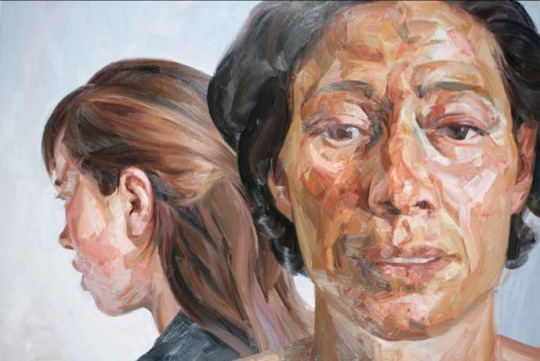
Interpreting line
The Visual Element of Line is the foundation of all drawing. It is the first and most versatile of the visual elements. Line in an artwork can be used in many different ways. It can be used to suggest shape, pattern, form, structure, growth, depth, distance, rhythm, movement and a range of emotions.



We have a psychological response to different types of lines:
Curved lines suggest comfort and ease
Horizontal lines suggest distance and calm
Vertical lines suggest height and strength
Jagged lines suggest turmoil and anxiety
The way we draw a line can convey different expressive qualities:
Freehand lines can express the personal energy and mood of the artist
Mechanical lines can express a rigid control
Continuous lines can lead the eye in certain directions
Broken lines can express the ephemeral or the insubstantial
Thick lines can express strength
Thin lines can express delicacy
2 notes
·
View notes
Note
Hi! I love your art style! Your colours are very vibrant and you always capture the essence of a character! I was wondering how you drew your art pieces? What do you use and what steps do you take to make them? Who would you say is the hardest character in All Hail King Julien to draw?Do you have any tips for drawing lemurs + other AHKJ characters? 💚💛
You don't even know how much your words mean to me! THANK YOU HUNDERT TIME! People like you are a great motivation for me to keep going with my art and make people happy with my art cuz it was ALWAYS my big dream! To make people happy with my work! ~~ <3<3<3
“I was wondering how you drew your art pieces? What do you use and what steps do you take to make them?“
To be honest, I'm not willing to give advice on drawing techniques, because I'm self-taught, I have never participated in any workshops. All I can is what I have learned by trying different things and watching others. Usually when I give advice, there will always be someone who draws professionally and points out the mistakes that I certainly make from a prefesionalist point of view.
Therefore, if you are looking for professional advice, you should certainly ask someone else! XD I don't want you to get into bad drawing habits.
BUT if you want to know how I do it and what motoda I practiced it is fine. I will show you what and how. ;)
I will explain everything in turn using one of my drawings as an example. (That’s humanisation of Becca from AHKJ, of course. ;))

At the beginning I make a sketch. As long as I think it's good enough! XD I follow the pictures of the characters to best convey important details. I draw some of them from memory. ;) I use a regular school pencil and eraser to make a sketch. You can buy all this at every market.
Then I do lineart and I use eraser to remove pencil residue. To make lineart I use pigment ink, usually: uni pin fine line or Faber-Castell Ecco Pigment but normal fineliners are also great and sometimes I use them too!
When the lineart is ready it is time for the colour base. This is very helpful because the color is even and there are no unsightly clearances. Personally, I recommend Winsor & Newton Promarker but to be honest I didn't use others, that's why I don't have a real comparison. I can only say that promarkers fulfill their role well. For small surfaces I also use regular markers. They are easier to get and also work ok. :) Promarkers are expensive and you can buy them mainly in art stores.
The next step is shading and giving shape and depth using colored pencils. In my opinion, this is the most important step in creating each drawing. I have been using Bruynzeel crayons for several years because this set of crayons I got as a gift once and I still use them, but in the case of some colors I also use the usual random coloured pencils, which I have after school.
Actually, the work is ready here. I add white elements to get a nice effect on the eye. This is not necessary, but I like it. You can do it with a white ball pen or just like I do with a regular liquid concealer.
Optional at the end of the last color details that can be added to the already colored drawing (this is just an additional effect and some people do it in the program on the computer) and voila! Your art is done! It probably doesn't look like your imagination, but calm down. This is normal. ;)
“Who would you say is the hardest character in All Hail King Julien to draw?“
Oooh, it’s hard to say only ONE character! There is so many hard character to draw for me...
Aye-ayes are very difficult for me because I can't draw their wrinkled skin so that it looks quite natural. In my performance it looks ... strange.
It often happens that some lemurs drawn by me do not completely resemble their original counterparts, because I can not quite keep their characteristics. However, Dorothy is certainly one of them, but sometimes Horst and Pancho (if not his specific fur color, it would be hard to guess that I drew him :P).
It's difficult to draw Rob's hairstyle too. It hurts cuz I like drawing him!
Indris (mountain’s lemurs) are too hard to draw because their strange body shape.
I’m not good with drawing snakes + Dr S has kind of athypical designe and if you draw him with normal cobra head he look completelly different. Not so cute! ;)
Clover/Crimson is hard to draw becuase her head shape. This is a typical pattern used to draw lemurs' children, but you can't follow this lead. She is not a child.
Tammy! OMG, no comment! I can’t draw her! :(
Hands... or maybe wings of Andy are complicated to draw... They works more like wings or hands? XD
As you can see, it's very difficult to choose one or even a few characters that are the biggest problem for me. I'd rather say that each character has one (or more) drawback that makes me cry when I draw it. ;)
“Do you have any tips for drawing lemurs + other AHKJ characters?”
My advice is to draw the way you feel! Do not worry about the fact that something doesn't look like in the show, or that you add some features for canon character. I saw a lot of people who draw according to their own concept and be sure that it doesn't spoil the reception of these characters! On the contrary! It lets you see something more in these characters. Something that the artist sees, and everyone interprets characters in their own way. It gives inspiration to another artist. You can view photos of real lemurs, but you don't have to. Some people draw lemurs as if they were cats. I assure you, however, that lemurs in no way resemble cats, neither appearance nor character ... but what's wrong with someone presenting them in this way? NOTHING! Everyone has the right to their own interpretation. And who knows, maybe something will come of it.
My advice is be creative and try different things! There are no bad fans! And there are no bad artists (they are only inexperienced). Each of them is trying to convey something and enrich the fandom with a new point of view! Be one of them and throw away the conventional thinking that leads to nowhere.
Thank you very much for your amazing questions! You made my day! ~~ ^^
And sorry for my English!
14 notes
·
View notes